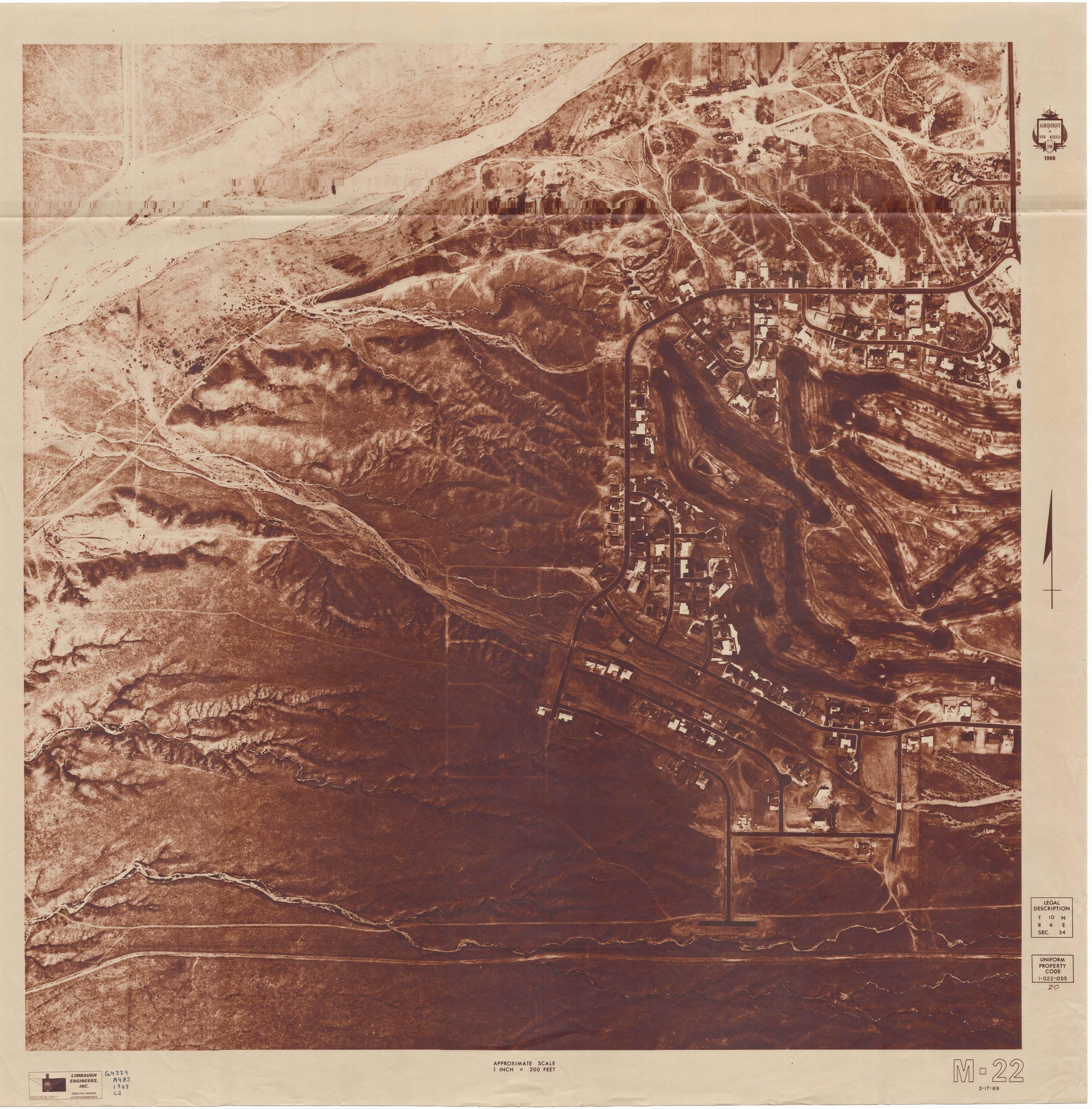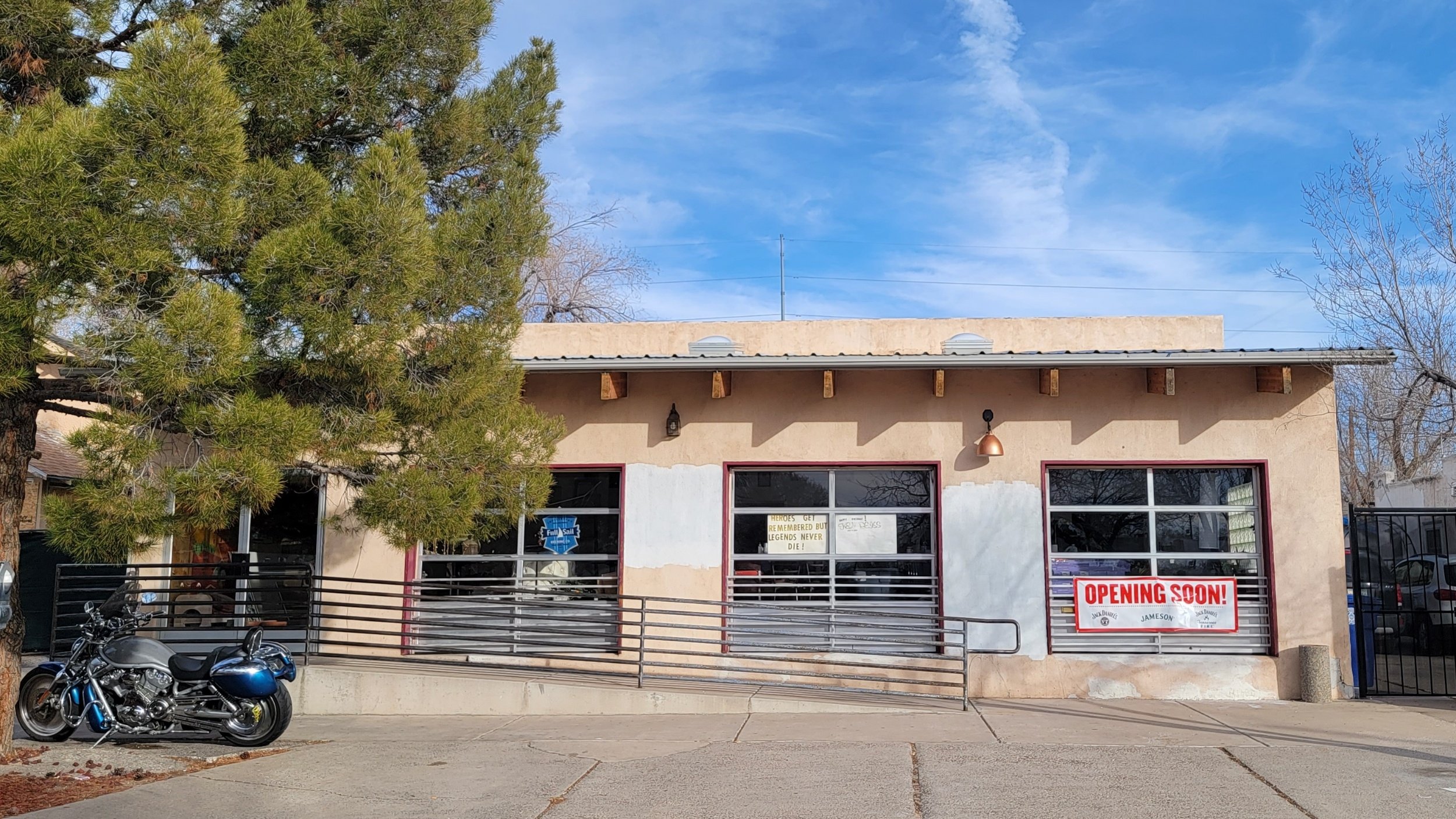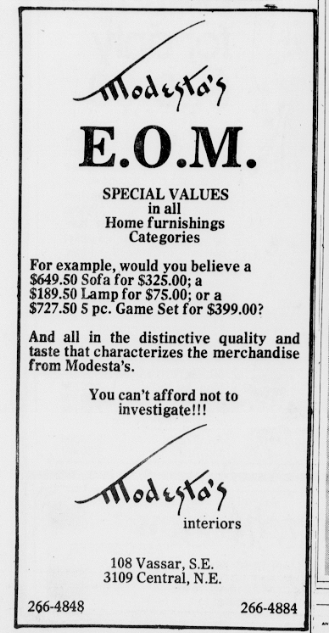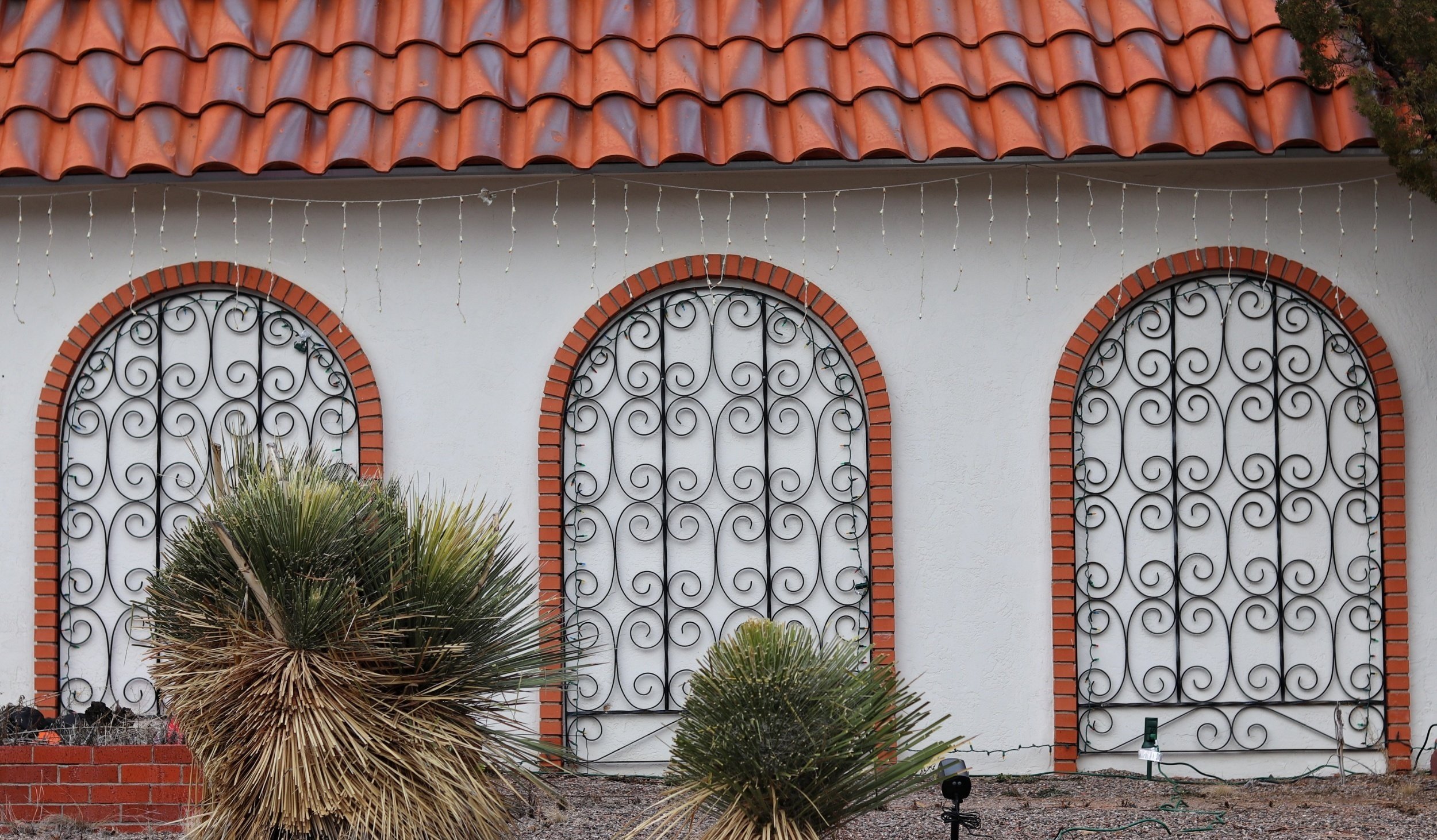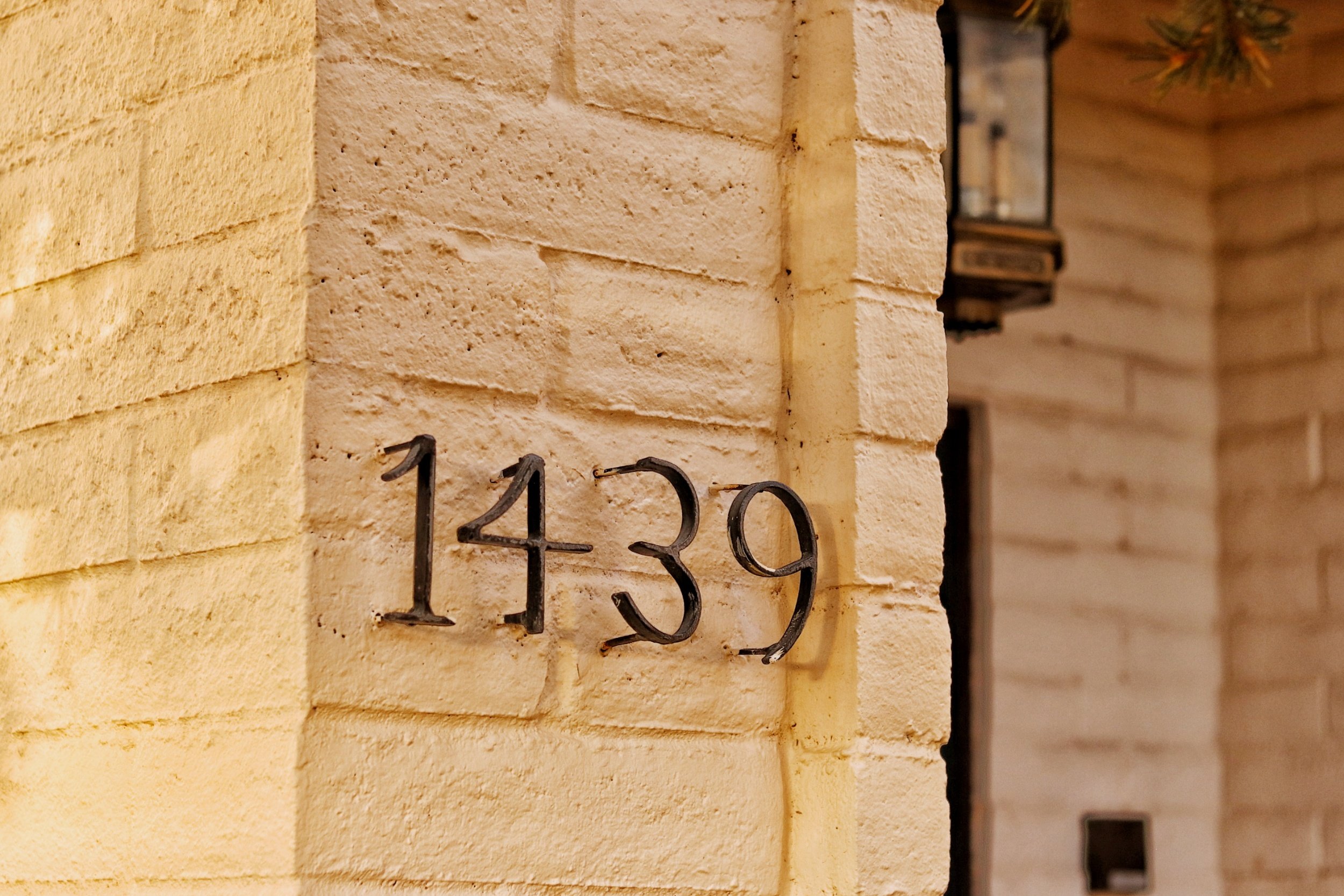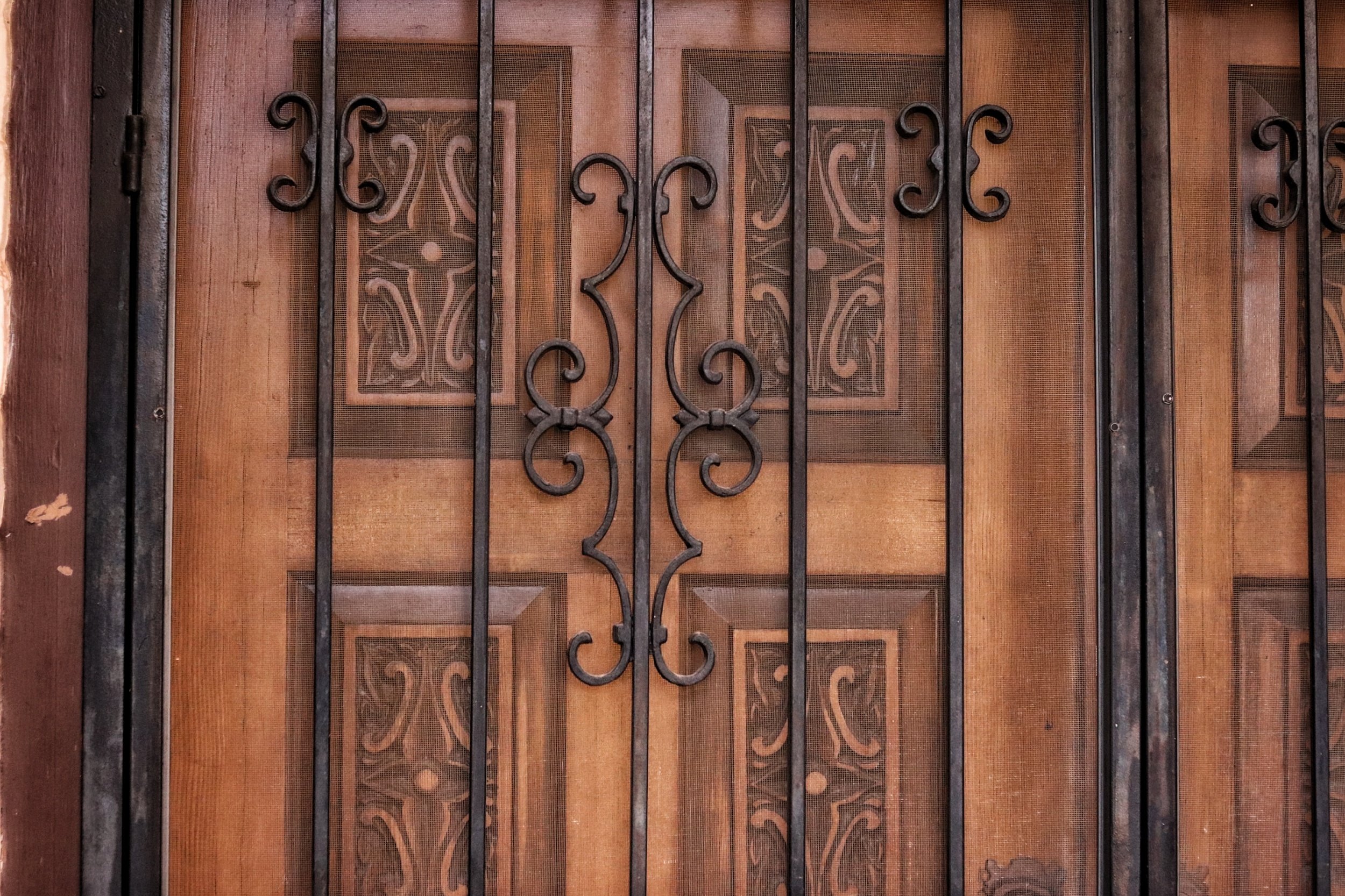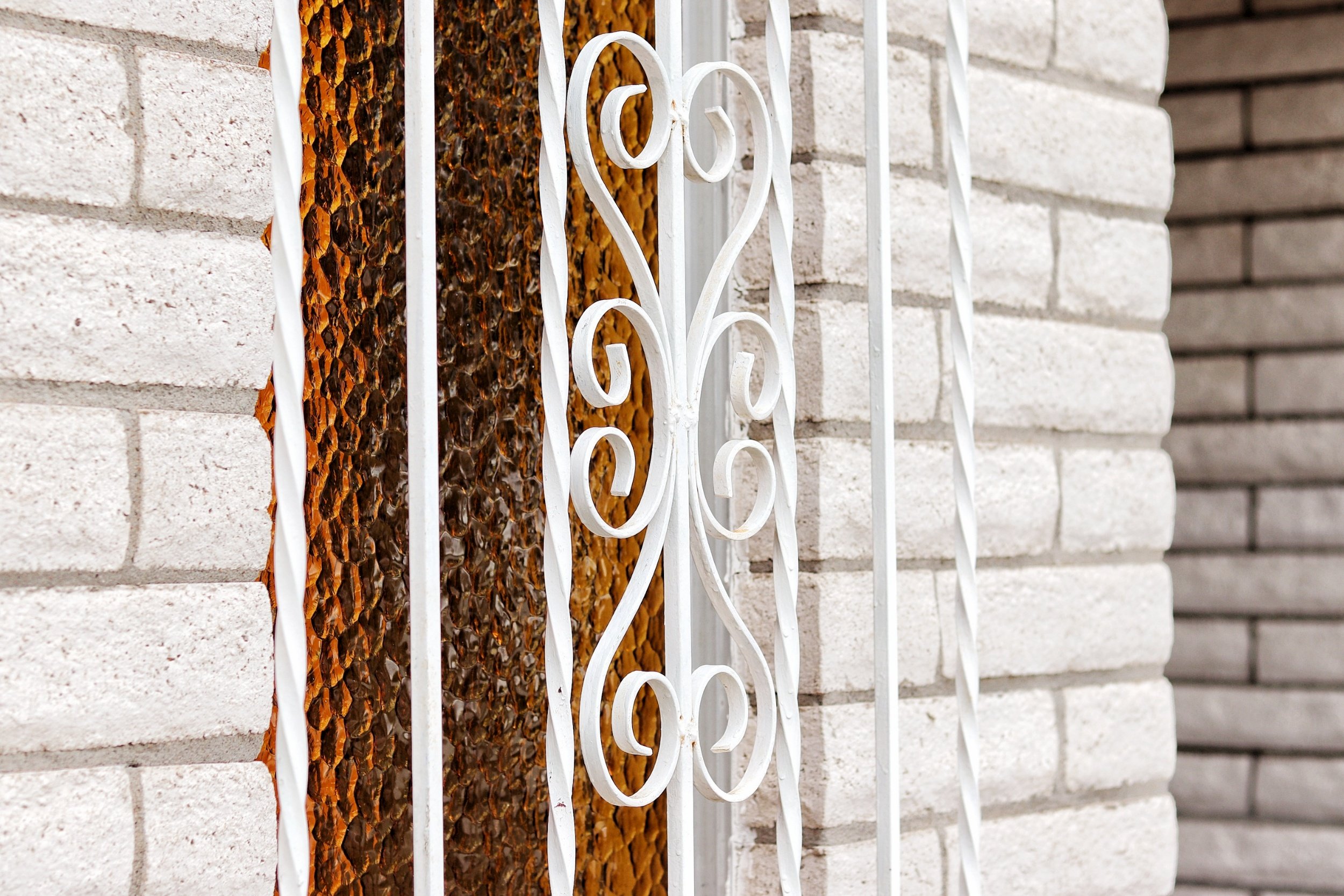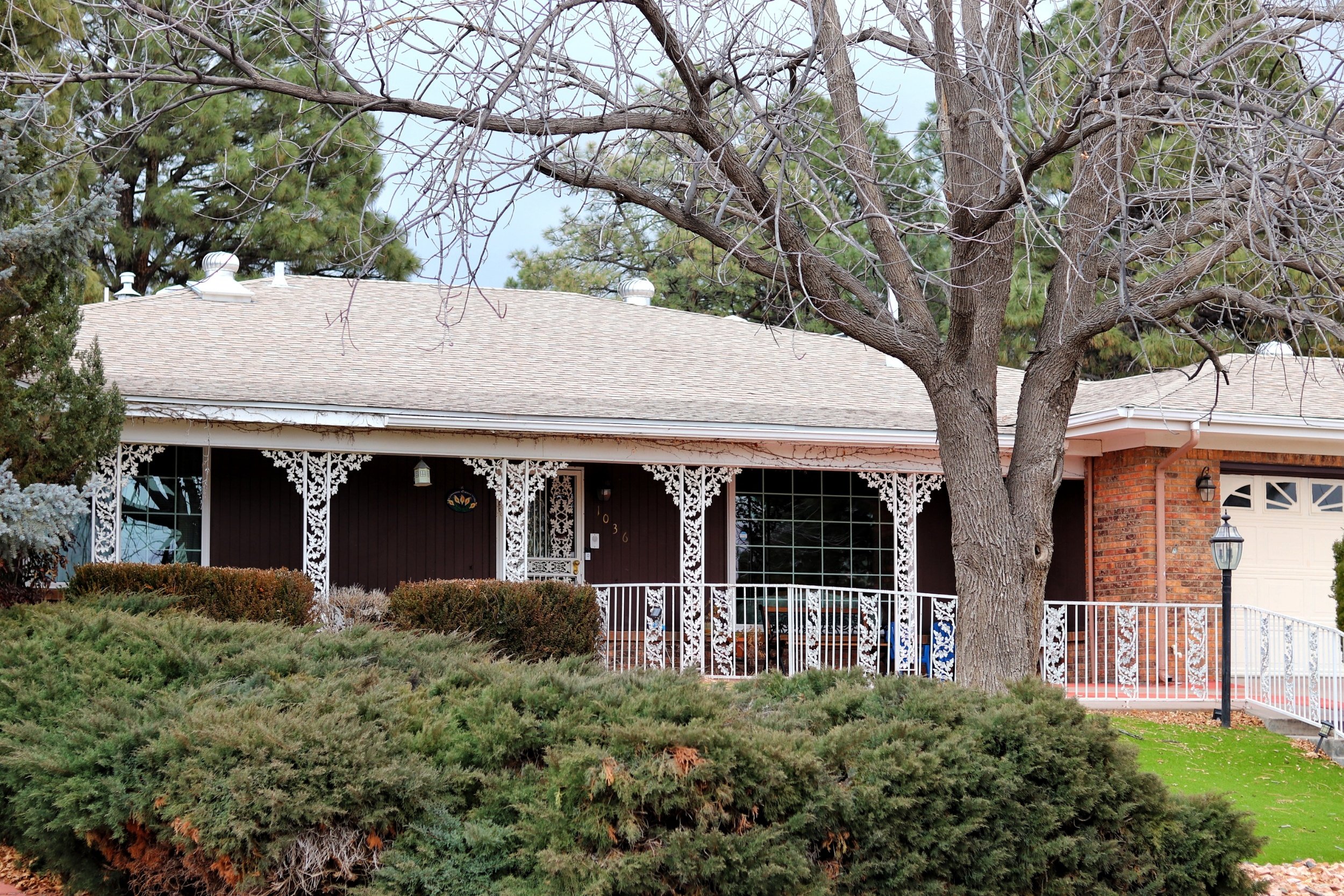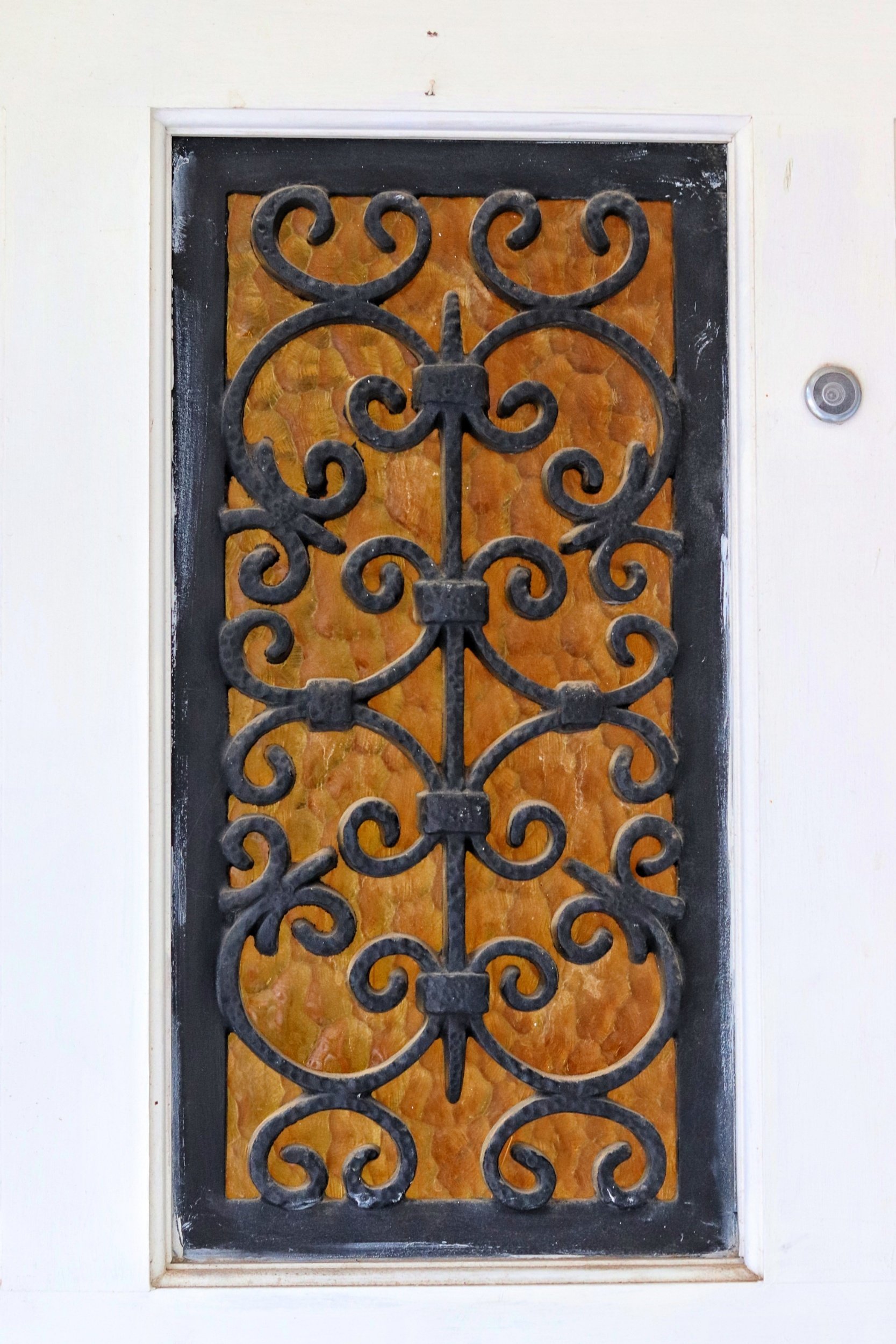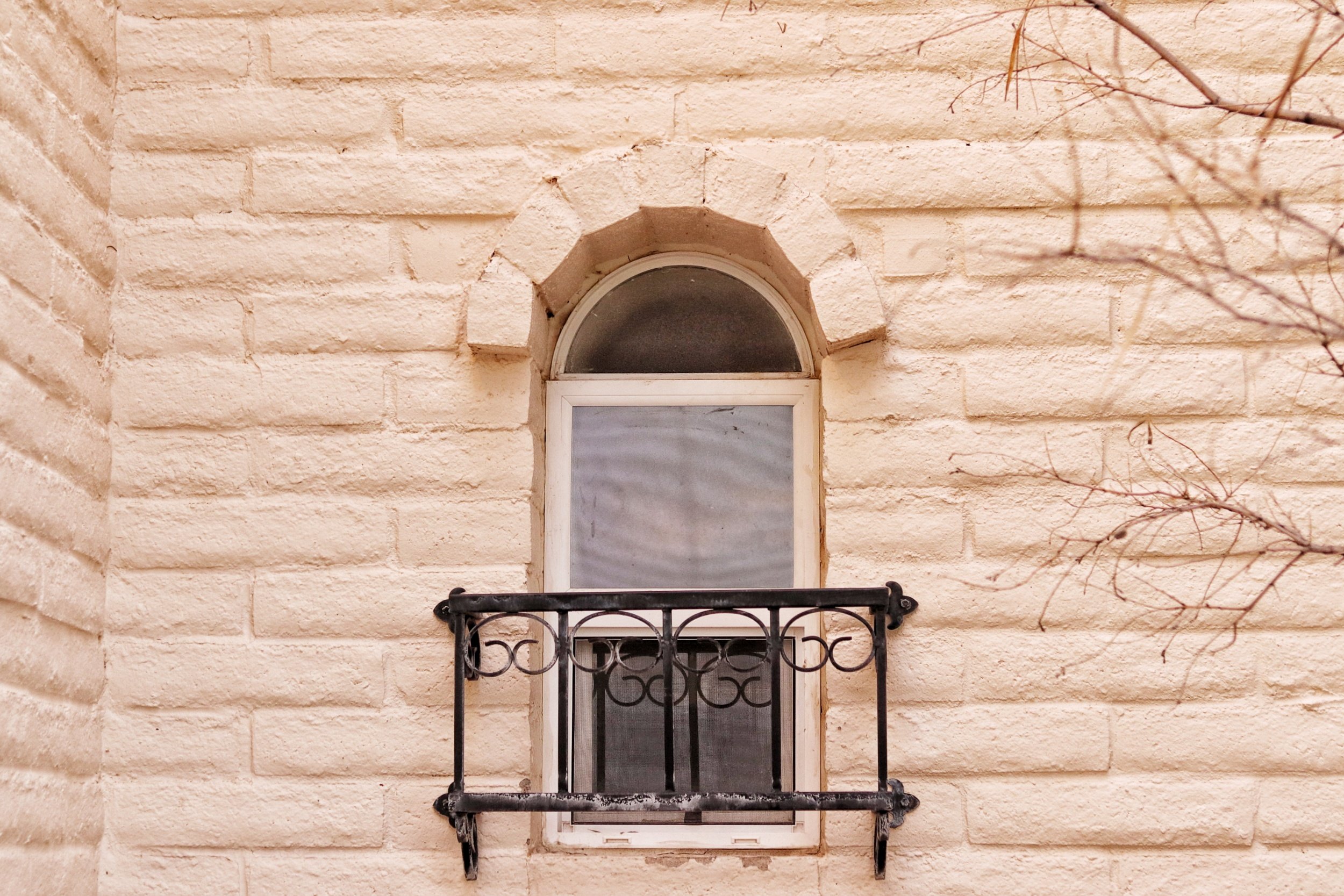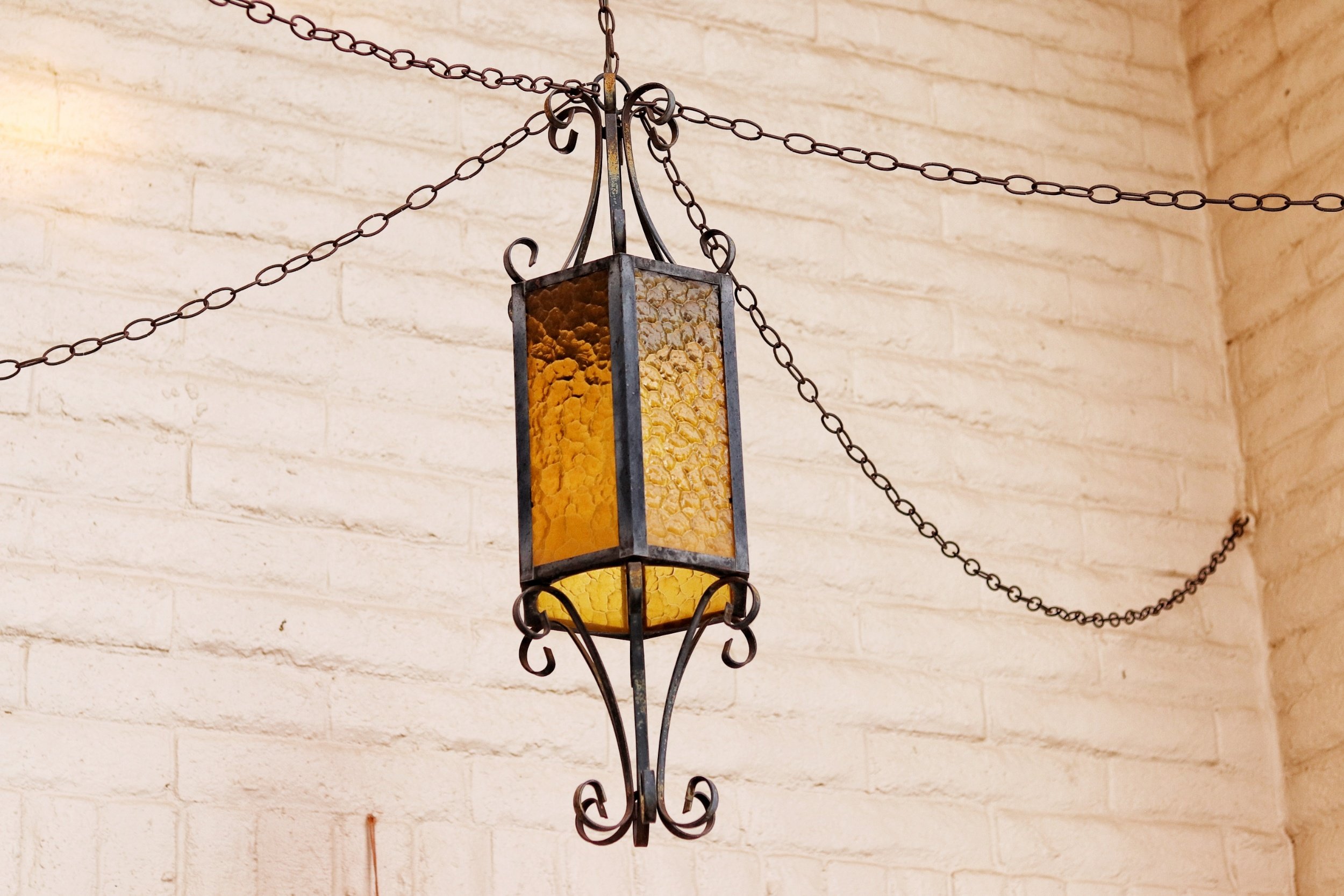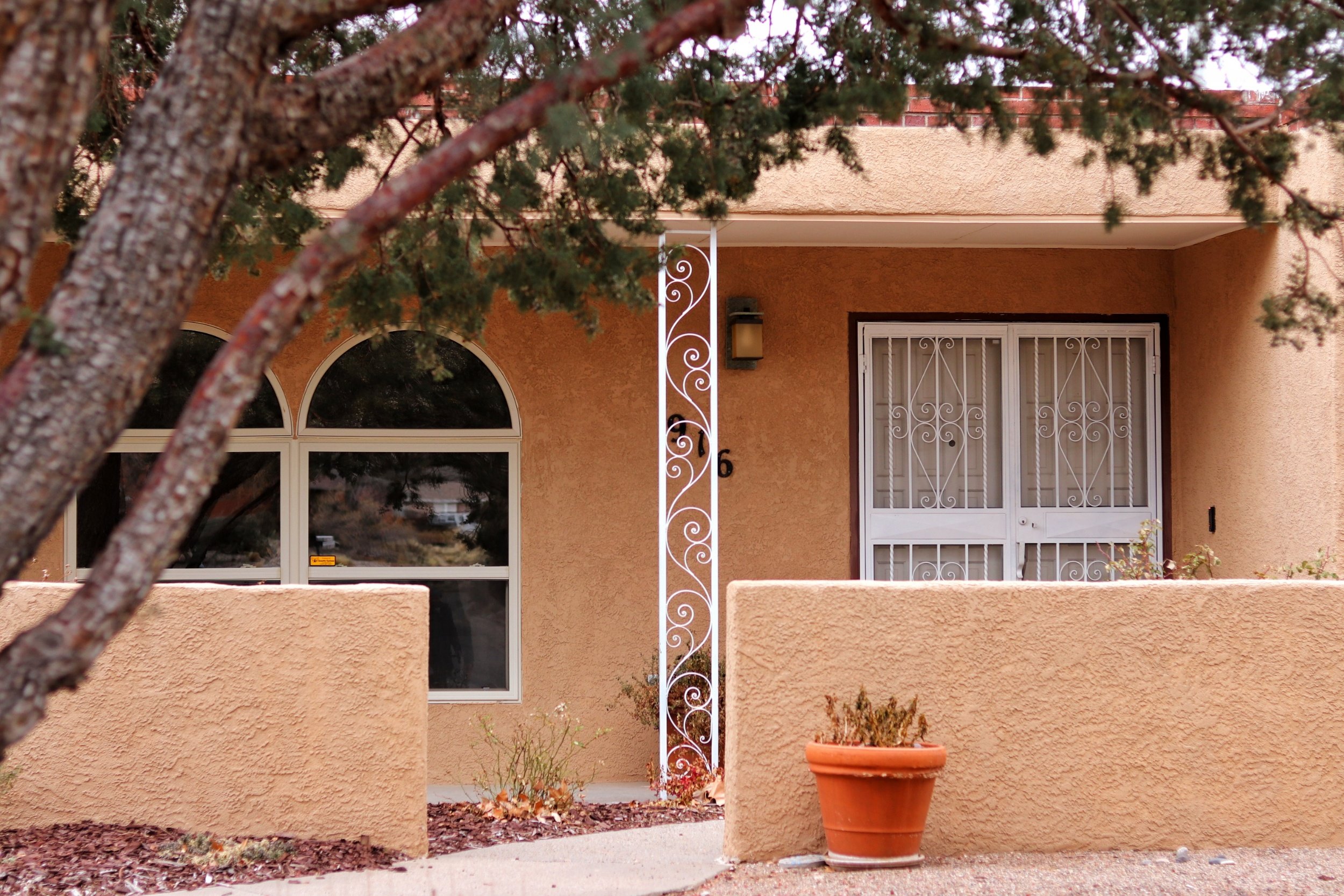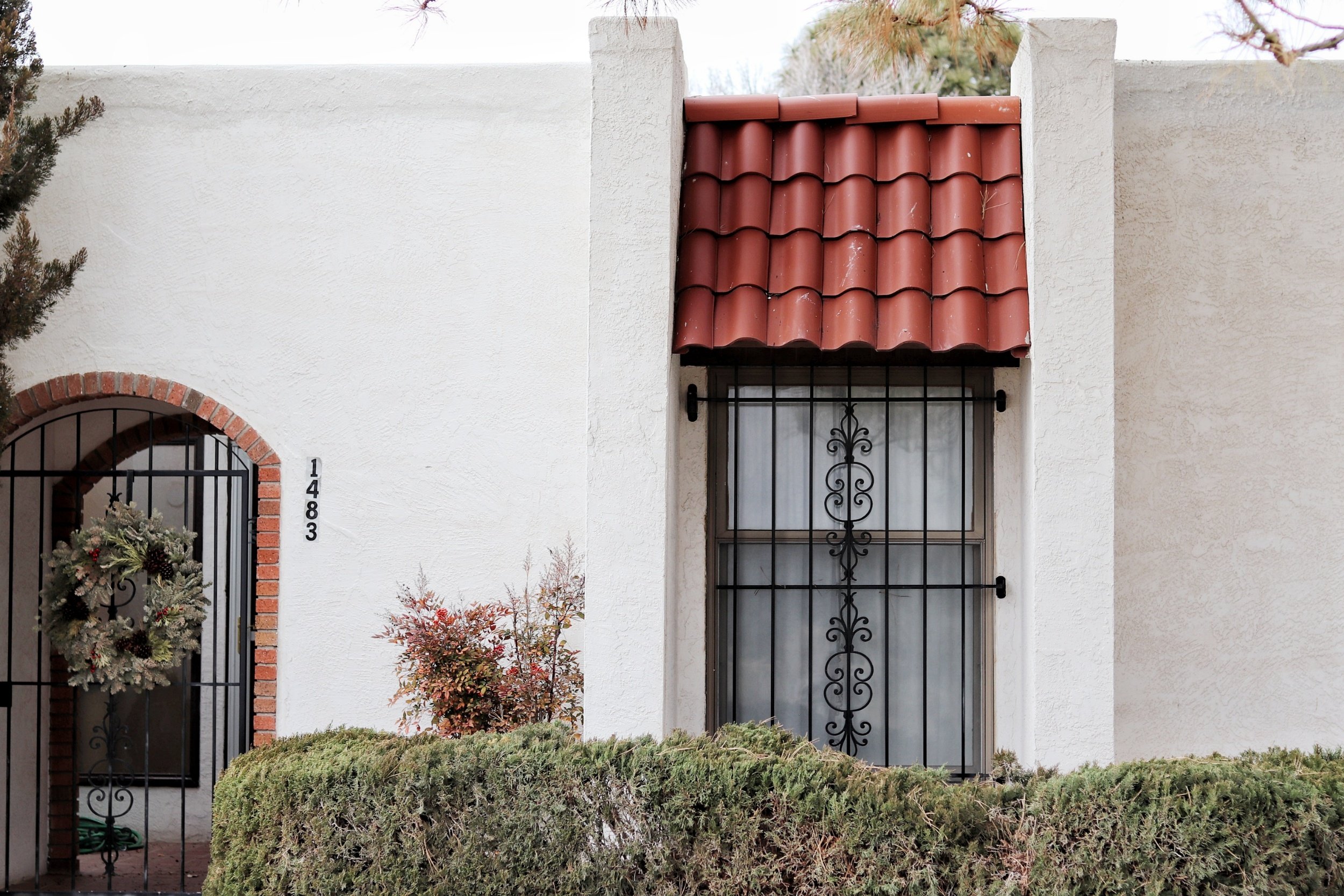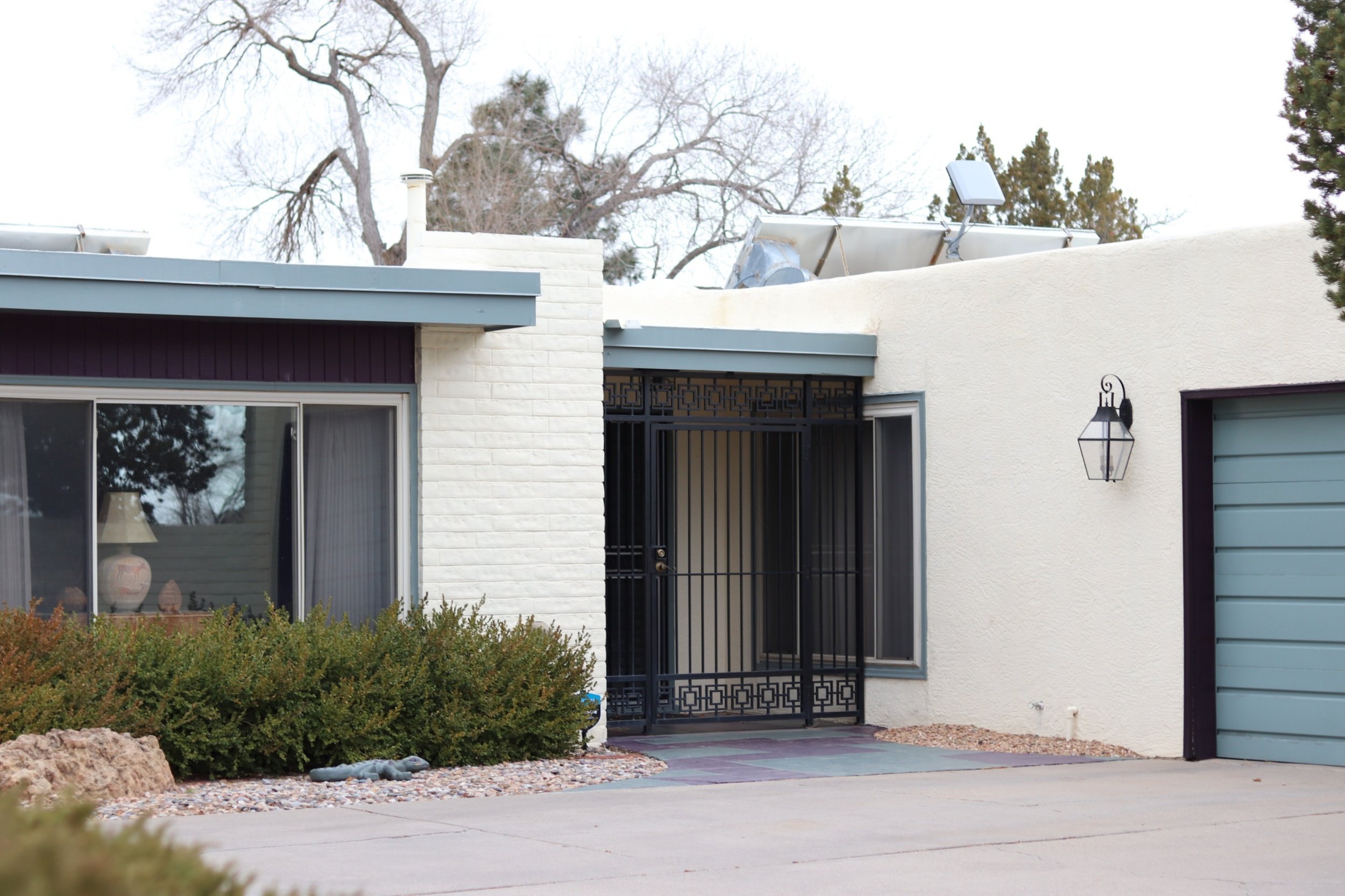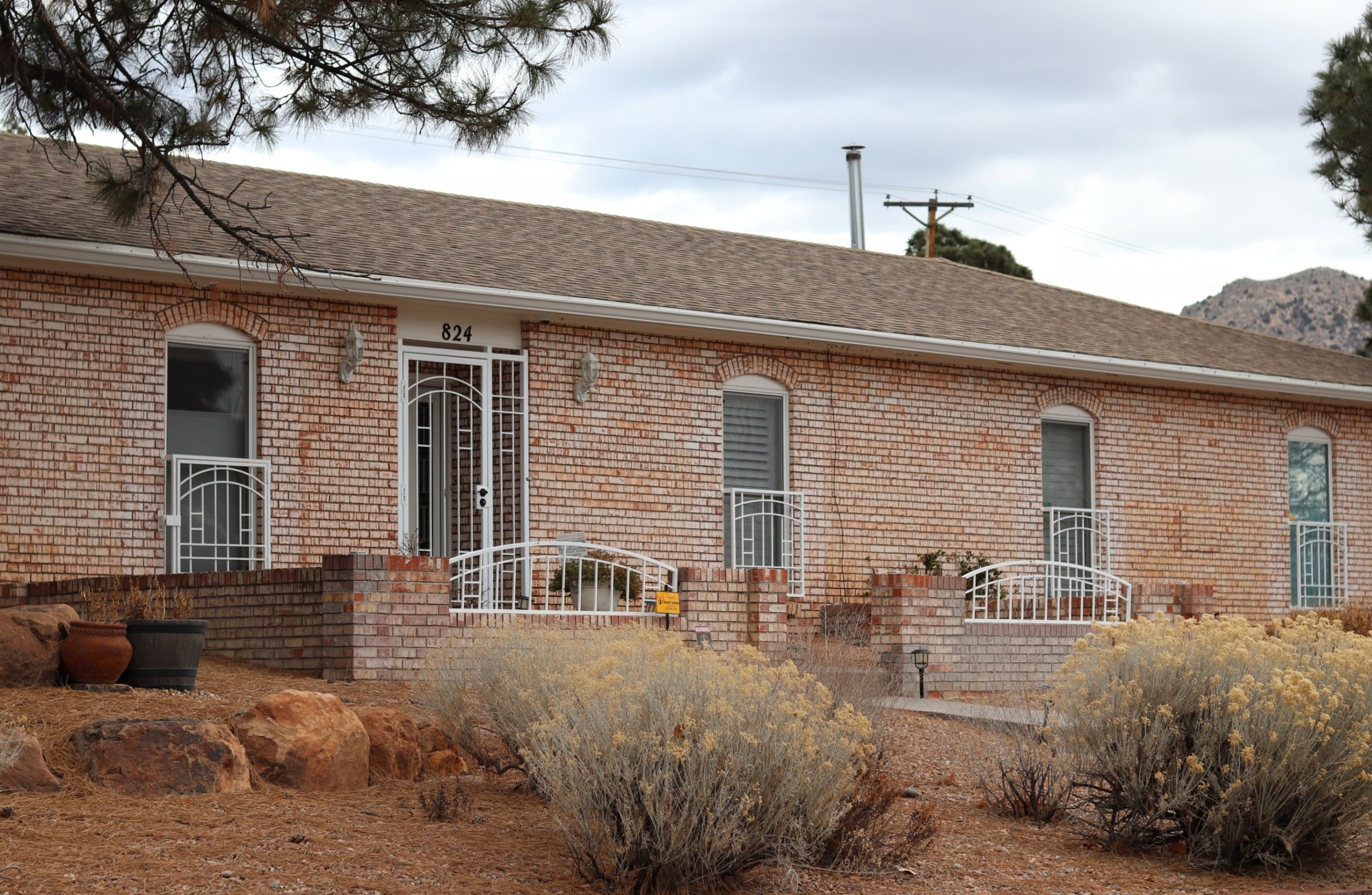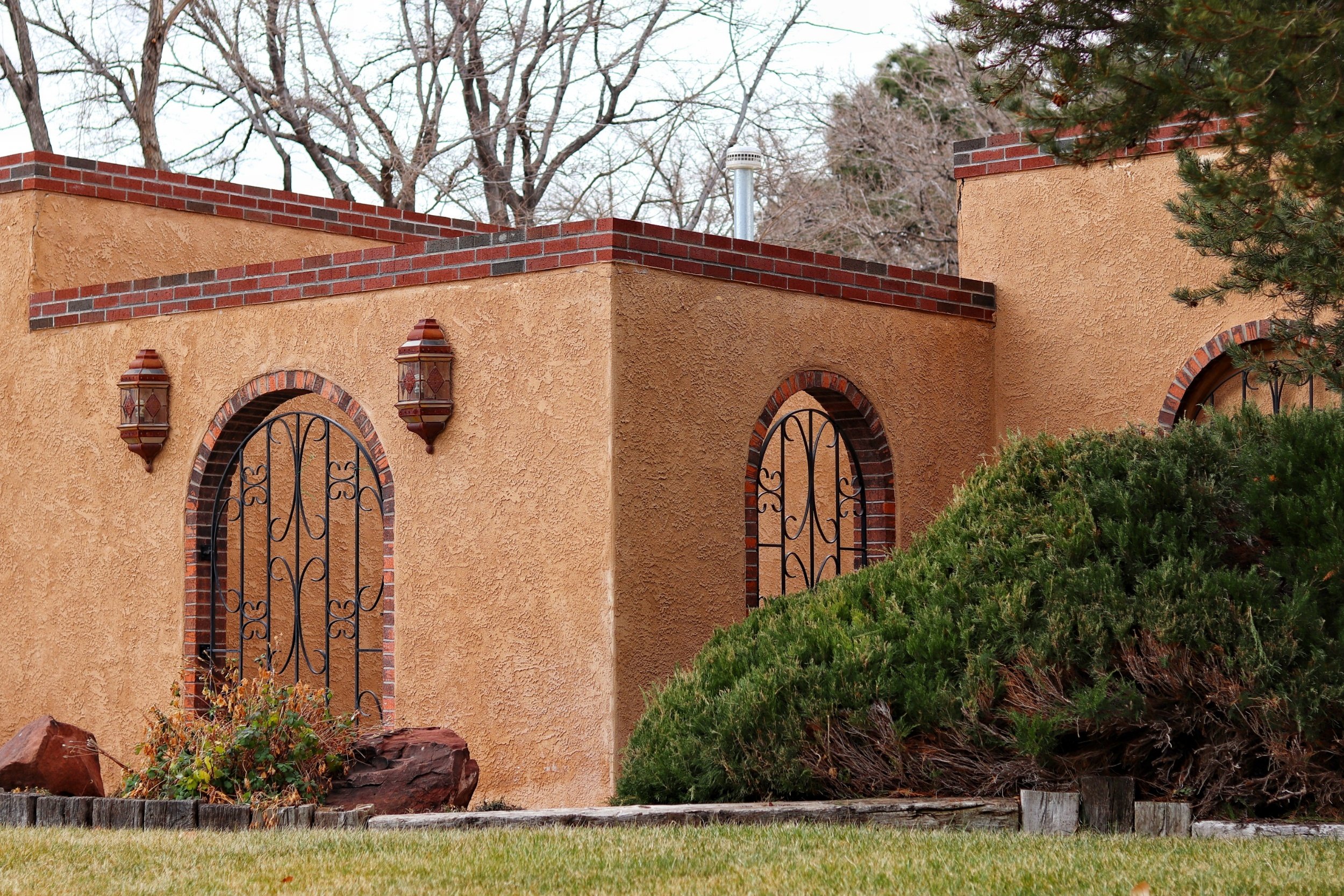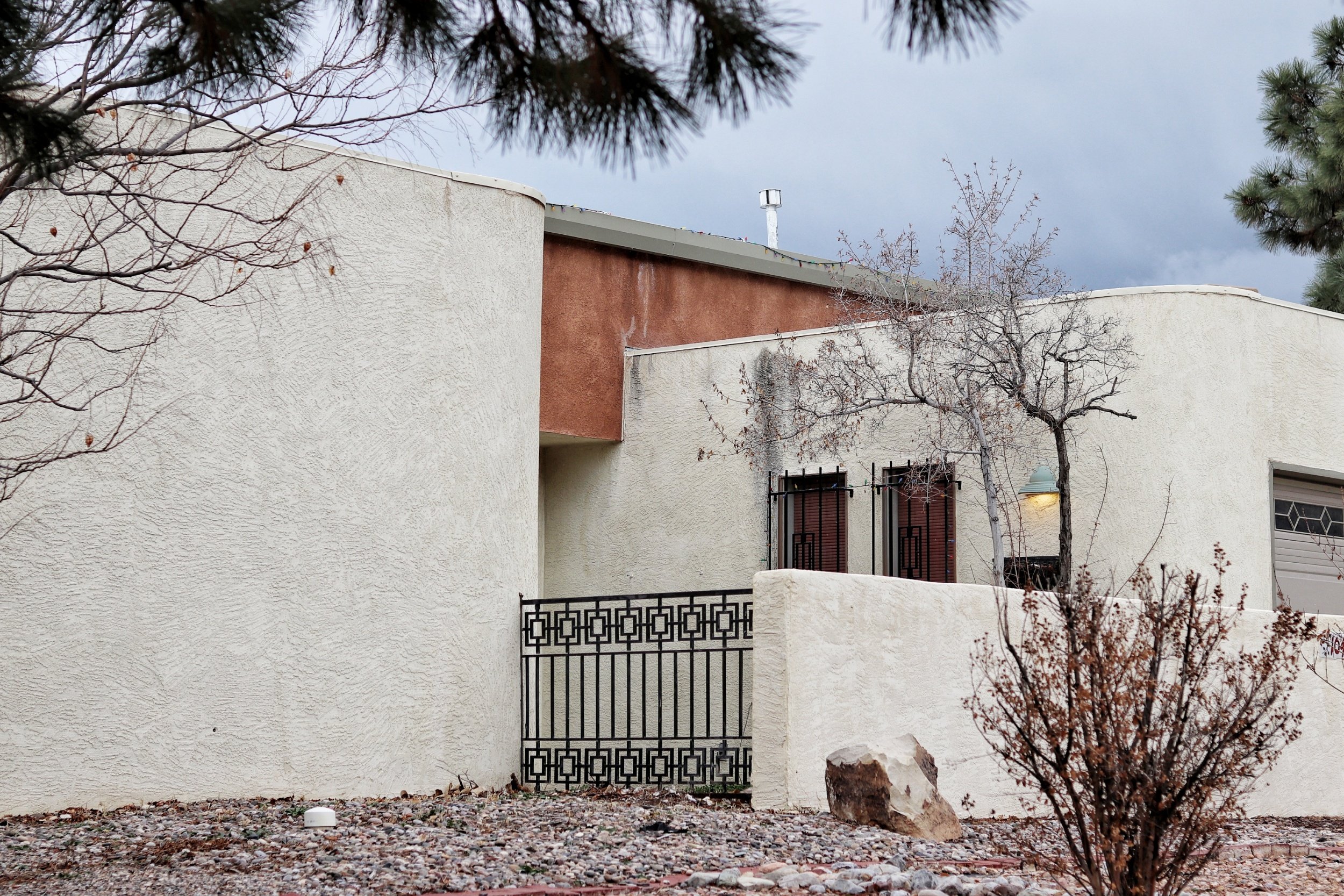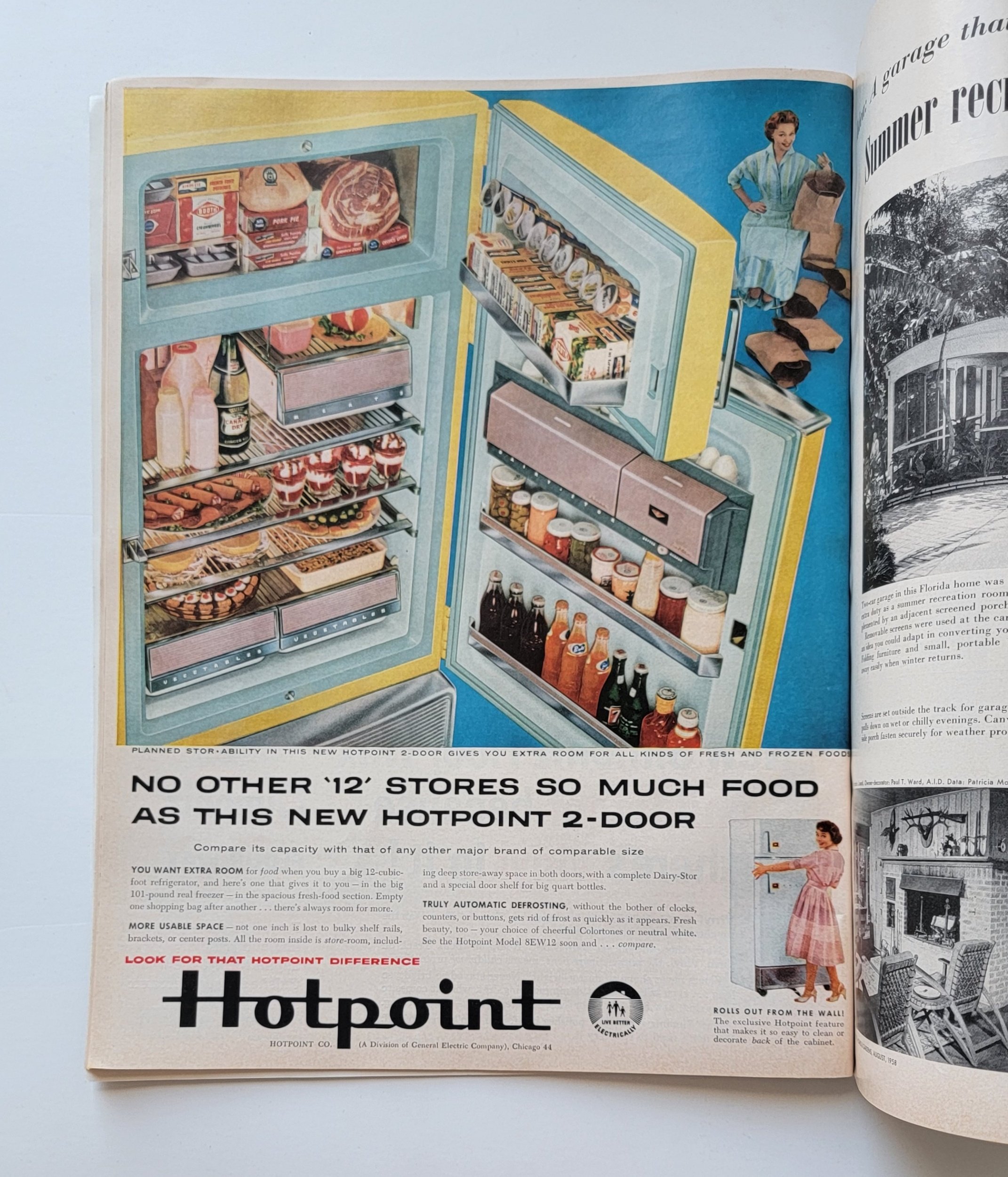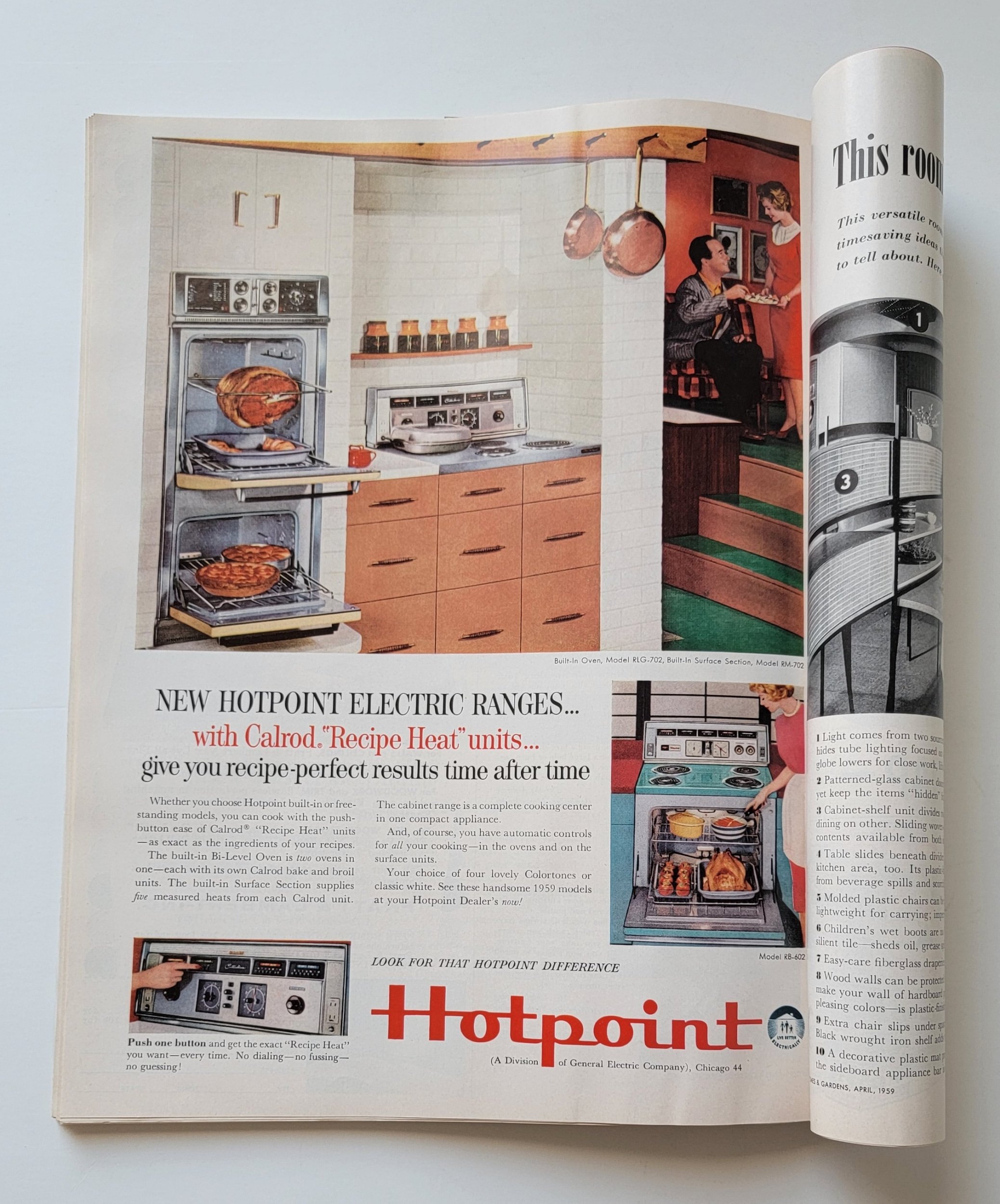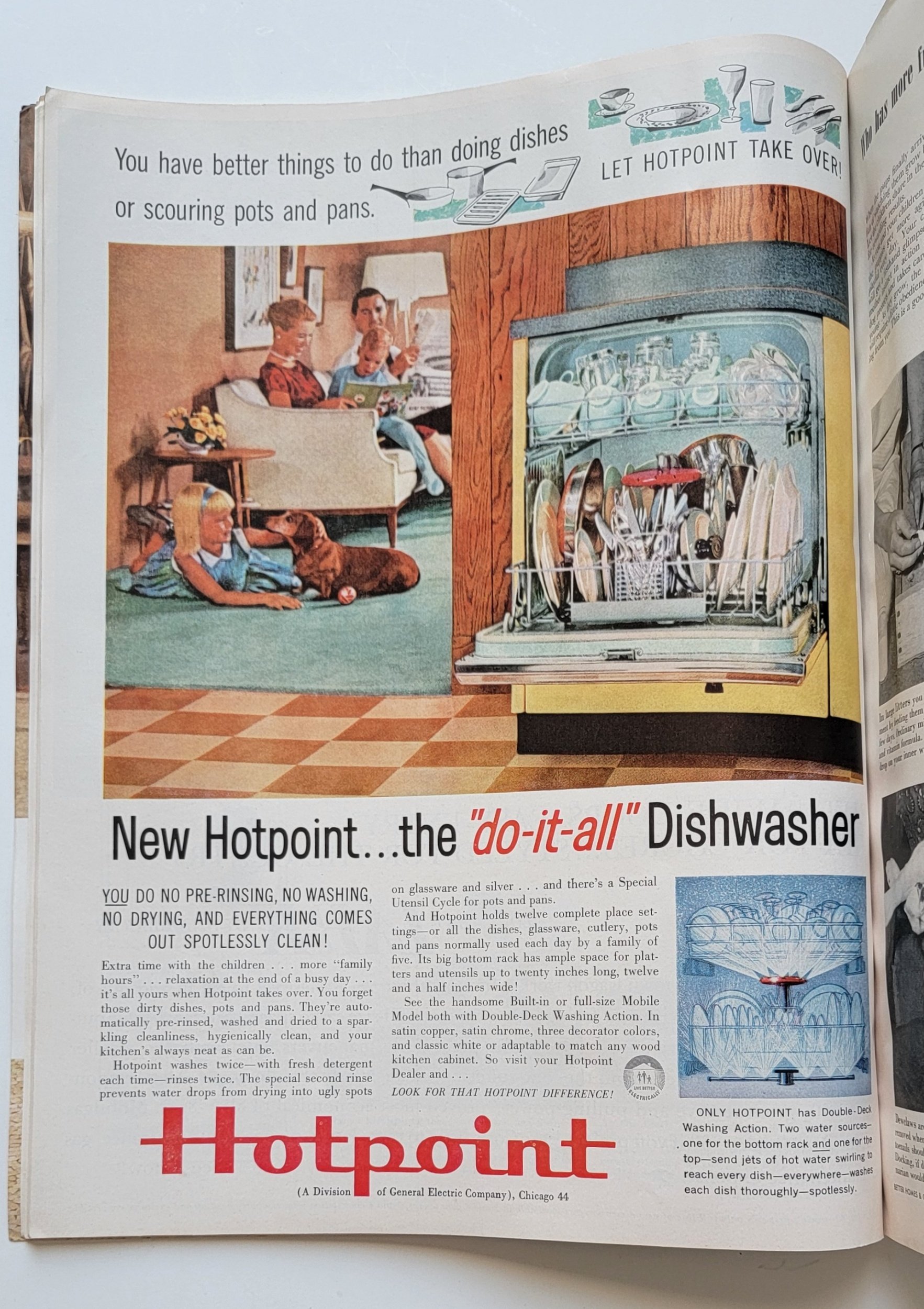
Hollywood Man Builds Bachelor Pad & Legacy in Four Hills
In this vintage neighborhood full of family homes, we are proud to introduce a swinging bachelor pad. The Four Hills Village Project team had been curious about the house at 644 Running Water Circle ever since our scan of Albuquerque Journal of Home Living Articles from the 1950s-1970s. It's an unassuming 2432 square foot home that looks mid-century modest from street view, but as we combed vintage newspapers, we saw the address come up again and again in highlights for its spacious design and “bachelor pad” vibes. Our team got to work and learned about the home, its original features, and the intriguing social history behind its original owner, builder, and designer, Herb Hoffman.
Herb Hoffman led many lives. After serving in the Merchant Marines during WWII, he moved to Hollywood in 1944. MGM Studios initially hired Herb as a messenger, but he worked his way up to scriptwriter, producer, director, then editor. His job at the studio took him around the world, directing low-budget films in Brazil, Japan, Malaysia, and the Philippines before moving up to the editing department for larger production movies. While in California, he started to move into the construction business. He worked his way up the industry just as he did with the studio, starting as an investor, then partner of a firm, designing custom homes and finally creating his own construction business. In 1963 Herb moved his custom design and construction business (Hallmark Homes and Development Co) to Albuquerque, New Mexico.
Once Herb Hoffman landed in Albuquerque, he set roots. Most of his business at the time was building custom houses in the Northeast Heights, along with other boom builders in that area like Mossman-Gladden and Bellamah. His portfolio included several commercial projects as well. Herb was the lead contractor for creating the New Mexico Film Center in 1968, a job he was picked for because of his prior film studio experience. The building became Santa Fe’s Center for Contemporary Arts.
Herb leaned on his experiences in Hollywood and construction when it came time to develop his own private “bachelor pad.” He bought a plot on Running Water Circle in the Four Hills Village neighborhood and broke ground in 1966. By this time, Herb had seen a lot and had plenty to draw inspiration from. He knew what he wanted; for the first time, he would be free from the frustration of having his grandiose visions of aesthetic forward homes dashed by clients to accommodate their young and expanding families. He incorporated several design and construction elements that created spacious environments in the modern luxury homes he had admired. Once Herb’s open floorplan bachelor pad was complete, it was a sight to admire. As a matter of fact, it caught the attention of several passersby and house-curious locals (and not just because his was one of the very few homes that filed for a sidewalk permit while the neighborhood was under a lot of scrutiny.)
Arial Photograph circa 1968, courtesy of UNM.
He says his custom-designed and built home was planned strictly for “ease of living and easy maintenance.” The entryway to the house contained a waterfall feature made of Siesta Canyon stone quarried from near Mountainair, NM. From there, the house opened into the vast “entertainment area,” a living room with a soaring 28-foot vaulted ceiling and walls entirely outfitted with high-quality elm and cedar paneling. Created to impress his guests, the living room focal point is a large 4 ½ foot fireplace made from the same local stone as the fountain. He said its 30-foot flue created “quite a roar and very cozy atmosphere.” Herb had a state-of-the-art hi-fi system built into the wall that provided booming sound with movie theater speakers acquired from a past life. Of course, the kitchen doubled as a bar, designed to face into the living room with pass-through serving areas for easy entertaining.
A shag-carpeted spiral staircase led to his second-floor guest area and living quarters. He had a fully tiled master bath with a 4x6 glass-enclosed sunken tub and hidden shelving behind walnut paneling. The home was built around Herb and his lifestyle as a bachelor with space to stretch. He could create more rooms when and if needed, but until then, open space was emphasized.
Albuquerque Journal; October 1967. “Club to Tour Four Hills Homes”
In October 1967, the Cosmopolitan Woman’s Club toured Hoffman’s estate along with three other homes in the neighborhood. (The other three houses were 632 Stagecoach owned by Mr. & Mrs. Willim Lancaster, 612 Wagon Train SE owned by Mr & Mrs. Arthur G. Fischer, and 704 Wagon Train SE owned by Mr & Mrs. John T Murray) The Albuquerque Journal published the tour itinerary and several details about each home. The article mentions that an aura of spaciousness and ease of living was at the heart of the design. They published a photo from the fireplace looking inward toward his living room, excellently showcasing the sky-high ceilings and spiral staircase.
Three months later, The Albuquerque Tribune ran a story about the Running Water estate in January 1968 titled “Four Hills Home Offers Lots of Space for Living,” which detailed several of his impressive design features and modern elements. The article is accompanied by a photo that peeks out from under the spiral staircase toward the stone fireplace. From this angle, you can see the wood paneling. Rightly stated, the caption is tagged “Bachelor’s Paradise.” When the article was printed, Herb would have been 45 years old. Incredibly groovy, to say the least.
The Albuquerque Tribune; January 1968. “Four Hills Home Offers Lots of Space for Living”
Aside from his Hollywood-style bachelor pad, Hoffman built two other (that we know of) custom homes for clients in Four Hills: 712 Stagecoach and 1020 Cuatro Cerros. The houses share hard geometrical shaped designs with blocky faces.
Herb retired from the construction business in 1988, which led him to the next life of the many he led. That same year he and his wife (yes, wife, it would seem the house worked its magic) took over a small computer business and renamed it Hallmark Computer Supplies. His computer business focused exclusively on selling cables which many people didn’t quite understand, but for those who depended on early computers of the 1980s, the business became a fundamental resource. The business grew substantially over the next 17 years and became the go-to spot for personal, enterprise, and government custom computer cable solutions.
The Albuquerque Tribune; January 1968.
The house at 644 Running Water Circle was well-loved and well-lived in. We can see through public records that Herb lived in this house until he died in 1997, after which his wife continued to live there until her passing in 2005 when it was sold to the current owners. Incredible but true, the house has had only two owners since 1966.
644 Running Water Circle still stands just a few doors down from Wagon Train Drive, but we are unsure how many of the original luxuries remain intact. Undoubtedly, over the decades, the construction hosted hundreds of guests over its lifetime, and several of them very likely remember it fondly.
____
Resources;
Albuquerque Tribune December 9, 1966
Albuquerque Journal October 8, 1967
Albuquerque Tribune January 6, 1968
Albuquerque Tribune February 2, 1968
Albuquerque Journal August 27, 1996
Albuquerque Journal September 6, 1997
How Four Hills Village Got It's Name
What is the origin of the Four Hills name?
The obvious answer would be the four prominent peaks in front of the Manzano Mountains directly south of the neighborhood. Others may know these peaks by what they are: Manzano Base or Manzano Waste Storage Site. And that answer is correct. But there is more to the story than that.
Anyone familiar with the history of Four Hills Village knows construction on our development began in 1957. Prior to that, the land that makes up most of this neighborhood (as well as Kirtland AFB, Sandia National Labs, and the Sunport) belonged to several homesteaders. Hardy V. Logan was the first major homesteader in this area, buying up large amounts of land between Tijeras and the four peaks throughout the 1920s. Logan is credited with being the first to call the area four hills. He built his house at the base of one of the peaks that make up the area’s namesake.
Wiley S. Johnson was next, spending the better part of the 1930s buying land on the East Mesa for cattle grazing. He called this land the Four Hills Ranch. This is the first recorded instance of using the Four Hills name in an official capacity rather than just a general name for the area. Hardy and Wiley did know each other quite well, so it is not surprising he would adopt the name for his own endeavors. Wiley eventually used his land to open the Four Hills Riding Academy, which was located in the arroyo just before you enter FHV. Wiley had a great deal of success with his riding academy throughout the 1940s and 50s.
By 1941, the Army Air Corp forcibly bought all but a couple of hundred acres of Wiley Johnson and Hardy Logan’s land for the purpose of constructing what is today Kirtland and Sandia. As plans for Four Hills Village and Country Club were finalized, both Logan and Johnson sold most of their remaining land to the development firm building the neighborhood. In 1957, Wiley sold the riding academy and moved to Moriarty. The academy became known as the Four Hills Stables and stayed in business just below the neighborhood for several decades. I am sure more than a few of our residents have ridden there.
Several newspaper articles highlighting the development of the golf course state the country club took its name from Wiley’s Four Hills Ranch. Later, a separate article about the club from around the same time gives a nod to Logan for being the creator of the Four Hills name for the area in general. It is these two homesteaders that we can credit for the Four Hills name. A century later, the name is still going strong.
*Frank Speakman was another major homesteader on the East Mesa. He used much of his land to build Albuquerque’s first airport, where Kirtland AFB and the Sunport now sit. Most of the land used to create Four Hills was his before selling it to Harry Driver’s company for the development of the neighborhood. But that is a whole different story.
Sources:
Albuquerque Tribune 17 Sep 1979 Pg. A1 and A6
Albuquerque Tribune 24 Sep 1979 Pg. A1 and A6
Albuquerque Tribune 25 May 1988 Pg.. 36
Albuquerque Tribune 15 April 1985 Pg.. 3
Albuquerque Journal 17 May 1946 Pg. 15
Albuquerque Journal 31 May 1946 Pg. 16
Albuquerque Tribune 29 May 1957 Pg. 1 and 12
Albuquerque Tribune 12 June 1957 Pg. 21
Albuquerque Tribune 12 February 1973 Pg. 14
Albuquerque Tribune 23 April 1979 Pg. 34
Images from Our MAGIC Field Trip
The Four Hills Village Project recently had the opportunity to explore the world of historical aerial photography from the mid to late 1900s. Our trip to the Map and Geographic Information Center, also known as MAGIC, at the University of New Mexico allowed us to delve into the area's development history and better understand the surrounding region.
Kimberli using a magnifying glass to get a better look at a high resolution historic map.
Aerial photography in the 1960s was a significant milestone in cartography. The development of advanced cameras and planes capable of capturing high-quality photographs from above allowed for creating detailed maps on a scale never seen before. The pictures could be used to monitor the growth and changes of cities and towns, as well as for scientific research and military purposes.
Schannan Westman Huston. Albuquerque, NM over Four Hills Village. April 16th 1974
During our visit to MAGIC, we had the opportunity to view several large aerial maps of the Four Hills Village development and the surrounding region. With the help of Cheyenne Stradinger, MLIS, the Library Services Coordinator, we explored the basement-level archive at the Centennial Science & Engineering Library. Cheyenne was instrumental in assisting the group, retrieving maps, and providing magnifying glasses to aid in viewing the intricate details of the maps. She also suggested additional resources, such as road maps, fire insurance records, and archives hosted on the campus by the Earth Data Analysis Center (EDAC). We took her up on this, and the EDAC Resource & Information Manager, Sandeep Talasila, GISP, sent us a report on everything he has pertaining to Four Hills between 1957 and 1975. 👌
Limbaugh Engineers Inc. Albuquerque, NM over Four Hills Village. April 3rd, 1966
One of the most exciting aspects of our visit was viewing the changes that occurred over time, from the original houses to the sprawl that followed. The team was amazed at how much the area had changed since the maps were created. The original homes were more rural than expected, and even ten years after the first homes were built, vast land areas remained undeveloped. It was also surprising to see how much of the Earth's natural water flow had been developed over, with entire streams disappearing from the maps.
Several historic maps and large copies stacking up on Cheyenne’s work station.
Aerial photographs can be an essential tool in preserving the history of our communities. They provide an unparalleled perspective on the evolution of land usage, infrastructure, and natural resources. In particular, the maps we discovered could help us get Four Hills Village recognized for its historical significance. Tracing the changes in the landscape and architecture over time gives us a more comprehensive understanding of our community's past.
Limbaugh Engineers Inc. Albuquerque, NM over Four Hills Village. March 17th, 1969
Our visit to MAGIC was an eye-opening experience, and we were fortunate to have the chance to work with such knowledgeable and helpful staff. The MAGIC archive provides a wealth of knowledge and is an excellent resource for anyone interested in studying the area's history. We were able to print and digitize our findings, which we are excited to share with others interested in the history of Four Hills Village. The importance of preserving historical records and making them accessible cannot be overstated. We are grateful to have had the opportunity to contribute to this effort and are excited to utilize these new resources for our research.
You’ll be hearing more about these maps soon!!
Scanning in the maps one by one so that we can publish them here on our blog!!
Four Hills List of Original Owners - First Installation circa 1959
The Four Hills Proper project is proud to announce a huge breakthrough for our archive and the home history of several of our neighbors!
When researching Four Hills this week in newspapers, we stumbled upon a never before seen article that lists information about several 1st installation homes! Thanks to a kind donation, our team has recently acquired a paid subscription to a more in-depth and quality newspaper archive than what is freely available online through the local library. With this new database, we have encountered several more helpful articles, including this one from November 9th, 1959.
Albuquerque Tribune, November 9, 1959 page A-15
The addresses mentioned in the article have been updated to suit modern spellings of the street names for easier reference and search. We know that some addresses from the article are incomplete, duplicated, or fictional. Some examples of this are H.T. Driver at 1 Stagecoach Lane, which we know from other research is Harry Driver, a significant investor in the Four Hills Development whose house was one of if not the very first built in 1959 at 1309 Stagecoach Lane. You will find that Brannin reported a duplicated address at 1006 Warm Sands Drive. The article states the address as listed by C.R. Shelly and under construction by Francis Barton. We know this home was owned by Dr. C. Richard Shelly and designed by the family but built by Sherwin Barton in 1959. The home listed at 150 Sagebrush is meant to say 1500, which we know from previous research on the Rutherfords.
This article is a fantastic find for anyone looking to learn more about their home history. Still, with so many known issues with the list, it’s worth cross-checking Brannin and the Albuquerque Tribunes' work against other resources.
Homes listed in Bill Brannin’s Albuquerque Tribune November 9, 1959 report- North of golf course
Homes listed in Bill Brannin’s Albuquerque Tribune November 9, 1959 report - South of golf course
If you have questions about your home history that we could help with, please feel free to reach out. We keep a growing list of resources to offer anyone interested in doing their home research. Please keep in mind that our growing Archive has information on over 300 residences in Four Hills Village but that we only document the architectural and social history from 1959 through 1975.
If you are interested in our newsletter, please join us! We write articles about Four Hills architecture and history when the mood strikes, or we find something too good to keep to ourselves. About twice a year we send our blogs out to neighbors and supporters along with some behind-the-scenes insights. We plan to host educational walking tours in good weather as well so it's worth staying in touch either on social media or via email.
We hope that you find this transcription helpful and exciting. If there is more that we can do, please feel free to reach out!
Your neighbors on Wagon Train,
Kimberli and Nick.
—
Transcribed from Albuquerque Tribune, November 9th, 1959, page A-15 with edits to match modern-day street name spelling.
—
15 Four Hills Village Luxury Homes Finished
Fifteen luxury homes, which range in value from $50,000 to $80,000 each, have been completed in the new Four Hills east of the city.
The Village is in the Manzano foothills and adjoins the new Four Hills Country Club.
W.D. (Bill) Brannin, who figured in the development of the Village, told of the homes constructed and others planned.
Mr. Brannin also had a significant role in building the $2,000,000 country club, which has an 18-hole golf course and occupies 150 acres.
City Utilities
The first unit of the development, with 118 residential lots, has all utilities plus paved streets, curbs and gutters.
These improvements include a paved street from the Western Skies and a bridge over Tijeras arroyo. The Four Hills Development Corp. is owner of the land. Brannin said that more than $1,000,000 has been spent in developing the Village. A sewage lift station had to be developed.
Brannin listed these occupied homes, their owners, and the value on them (the Village does not use the city quadrant system of street markings):
V.G Barabee, 1007 Warm Sands Drive, four bedrooms, $60,0000.
George Bender, 1015 Maverick Court, three bedrooms, $45,000.
H.T. Driver, 1 Stage Coach Lane, four bedrooms, $75,000.
Others Listed
Marvin Dunlap, 1003 Stagecoach Road, four bedrooms, $60,000.
Wayne Franklin, 907 Stagecoach Road, four bedrooms, $70,000.
James Liberty, 908 Lamp Post Circle, four bedrooms, $75,000.
George Mansur, 903 Martingale Lane, three bedrooms, $60,000.
C.R. Shelly, 1006 Warm Sands Drive, three bedrooms, $60,000.
D. Walley, 901 Martingale Lane, three bedrooms, $60,000.
Marshal. J. Wylie, 906 Lamp Post Circle, four bedrooms, $80,000.
In addition, four homes have been completed by Four Hills Builders and are on the market at prices ranging from $50,000 to $65,000. One at 1100 Stagecoach Road has five bedrooms.
Nine homes are under construction. The owners and their values, as listed by Mr. Brannin:
Harold Balay, 806 Four Hills Road, three bedrooms, $60,000.
Wm. McCollum, 902 Four Hills Road, three bedrooms, $60,000.
Francis Barton, 1006 Warm Sands Drive, three bedrooms, $60,000.
Charles Ricker, 150 Sagebrush Trail, four bedrooms, $65,000.
Louis Ruffin Jr. 1103 Stagecoach Road, three bedrooms, $60,000.
Save Spector, 1008 Stagecoach Road, three bedrooms, $55,000.
Max Ilfeld, 906 Four Hills Road, three bedrooms, $50,000.
Ward Bilderbeck, 904 Martingale Lane, five bedrooms, $75,000.
Mortis Smith, Stagecoach Lane, four bedrooms, $65,000.
Others Have Plans
Eight other sites are being prepared for construction. One of the large homes for George Rutheford, local builder, will be at 1609 Sagebrush Trail.
Other planning homes include
Claude Wylie, 1617 Sagebrush Trail
Benny Russo, 905 Lamp Post Circle
And Jim Allred 802 Maverick Trail.
Brannin said that in addition to the first 118 sites, the company has opened two additional units. A fourth unit, which will consist of 120 sites with some bordering the golf course, is being engineered. The lot sizes range from ¾ of an acre to 2 ½ acres.
—-
End of transcription
Miller Construction Company on Cuatro Cerros Trail
Vintage advertisement from 1967 confirms the builder as Miller Construction Company for multiple addresses on Cuatro Cerros S.E. in Four Hills Village, Albuquerque. The advertisement also hold the Live Better Electrically seal from the Gold Medallion Homes Program.
1308 Cuatro Cerros Trail
1312 Cuatro Cerros Trail
1316 Cuatro Cerros Trail
Albuquerque Journal. September 17, 1967 page 64
The ad reads:
Four Hills First Showing
1308-1316 Cuatro Cerros S.E.
Looking over Golf Course
Just completed new four bedroom & Den
with large walk-in closets, formal
fining room &living room. Also have
new 5 bedroom, 4 baths.
Come out and talk to
the builder
Miller Construction Company
Ph. 298-3437 Eve.268-5536
The Legacy of Modesta Interiors in Four Hills Village
Four Hills Village in Albuquerque, New Mexico, is known for its luxury homes and owners with "discriminating taste." These architect-designed homes started construction in 1959 and were decorated with great care to match the quality craftsmanship. During this time, one expert interior designer stood out for her impeccable taste, Modesta Comeford.
Modesta Comeford's story began in Wisconsin, where she grew up and attended White Waters State Teachers College for her B.A. and the University of Wisconsin for her M.A. before completing two years of law school. She moved to Albuquerque at the beginning of her career and worked as the in-house design consultant for Builder’s Furniture Co. on South Girard in the 1940s. In 1948, she and her husband, Joe, opened their own furniture and interior design firm, Modesta’s Maple Shop, later called Designs by Modesta. The showroom was located at 108 Vassar, a building that still stands today. Throughout the early 1950s, she designed interiors for several home builders, including Dale Bellamah, and earned a reputation for her impeccable taste.
First design job with Builder’s Furniture Company. Albuquerque Tribune. September 28, 1949, page 6
Dale Bellamah home furnished by Modesta’s Maple Shop. Albuquerque Journal. October 3, 1953 page 20
The location of Modesta’s Nob Hills showroom. 108 Vassar S.E. in January 2023
Mossman-Gladden further solidified this reputation when Modesta served as the lead designer for several of their developments, with Stardust Skies being her most significant project. Ads for the construction ran in the paper from 1956 through 1967. In 1963, the Mossman-Gladden firm bought an interest in Modesta’s, from here on out, advertised as Modesta’s, a Division of Mossman-Gladden. The merger expanded Modesta’s advertising reach, showing up several times in the Santa Fe New Mexican. She opened a new showroom at 2720 San Mateo Blvd. to serve Mossman-Gladden homebuyers. The two-story space (now a Big Five sporting goods store) highlighted the possibilities for purchasing a fully furnished residence in Stardust Skies.
The location of Modesta’s Stardust Skies Showroom. 2720 San Mateo in January 2023
One of the first Mossman-Gladden developments advertising furnishings by Modesta’s. Albuquerque Journal. September 2, 1956 page 39
Mossman-Gladden invests in Modesta’s. Albuquerque Tribune. June 24, 1963 page A5
In 1965, Modesta highlighted her firm's rising interior design talents through photographs, including her husband and business partner, Joe Comeford. By early 1966, people new to Modesta’s understood Joe to be an integral part of Modesta's business, and his face was regularly published beside hers in ads as an owner of Modesta's. With Joe running the shop, Modesta could focus on civic matters. She was voted in as Regional Vice President of the American Institute of Interior Designers (AID), making her the first New Mexican designer to hold such a prestigious position. When the new Boy's Club in the northeast heights began construction, Modesta was called on to contribute expertise for Decorative Appointments.
Ad with photographs of Mr. and Mrs. Comeford. Albuquerque Journal. January 30, 1966 page 99
Modesta's firm continued delivering fine furniture to the Albuquerque region. She traveled far and wide to meet new suppliers and ensure her business reflected her design tastes. In 1964, she brought Provincial furniture, Contemporary and Contemporary American Classics. She introduced new flooring, drapery, and carpeting styles to Albuquerque homeowners and home builders.
By 1967, Modesta's work with the Stardust Skies neighborhood was complete, and several more home manufacturers and owners were looking to her for interior design. Stasey Homes was one of the first home builders outside Mossman-Gladden with the "designed by Modesta's" mark. Stasey Homes completed the "Castillion" model at 8800 Delamar NE, which Modesta designed and promoted.
Stasey homes with interiors by Modesta’s. Albuquerque Journal. April 28, 1968 page 63
Several examples of her custom work also show up in Four Hills Village. 1200 Cuatro Cerros was the first, as far as we know. She did the interior design for this Gold Medallion estate. It was a standard example of luxury in Four Hills. The home at the corner of Cuatro Cerros and Matador Place (now called Bernalillo Place) had five bedrooms and 3.5 baths, which for 1968 was quite a space! Modesta chose the luxury carpet in the 35-foot family room.
Ad for 1200 Cuatro Cerros. Albuquerque Journal. February 25, 1968 page 59
1200 Cuarto Cerros S.E.. January 2023
1316 Cuatro Cerros was the next one we came across. A five-bedroom custom luxury home decorated by Modesta.
After that, we discovered she designed the interiors for Harold Chaffee’s Garden Homes development in Four Hills. These are a series of “indoor-outdoor” houses that occupy the northern part of the street up Santa Ana Ave. The addresses include 905, 913, 929, and 933, but presumably more since Harold Chaffee built most of the houses on that side of the street.
Ad for 905 Santa Ana Ave. Albuquerque Journal. July 19, 1970 page H2
Ad for 929 & 933 Santa Ana. Albuquerque Journal. May 16, 1971 page G-6
Ad for 913 Santa Ana Ave. Albuquerque Journal. January 31, 1971 page G-7
Ad for 1316 Cuatro Cerros. Albuquerque Journal. September 25, 1968 page G-6
By the mid-60s, Modesta Comeford was a New Mexican trailblazer in interior design. She was the co-chair for “Interior Design of ‘67”, a charity event sponsored by Pi Beta Phi alumnae, which displayed vignettes at the Holiday Inn. Not too much later, Modesta went on to teach a three-credit course at UNM called “The House and Its Furnishings.” The following year, Modesta taught a 12-week course, "Your Home and the Professional Designer.”
All the while, business at Modesta’s was ongoing. Sales and trends came and went. They opened a second showroom in 1974 at 3109 Central Ave N.E. (It is now Yanni’s in Nob Hill). Modesta achieved another New Mexico design community win when she was voted into the Regional President seat for the American Institute of Interior Designers. With this new title, Modesta traveled the world in search of beauty, speaking as an authority in interior design. She represented Albuquerque on regional and national stages, including the Interior Design Convention in Santa Fe in 1972, where she presented alongside representatives from Los Angeles, New York, and more to over 160 designers and professionals.
Modesta’s husband, Joe, died in 1975. After that, she continued to run her business and stayed engaged with the community. By 1978 she had moved out of her two main showrooms and consolidated her business into one location, 2420 Monroe NE. The last ad we came across for Modesta’s was from 1987. It was for a half-off sale, so presumably, she was closing the business. From there, we see nothing until her obituary in 1997.
Albuquerque Journal. July 25, 1973 page B-1
We do know that Modesta lived a long and fruitful life of 92 years, born in 1905 and died in 1997, highly respected by her peers after having made her home in Albuquerque beautiful.
Modesta's impact on the world of interior design and her contributions to the Albuquerque community is undeniable. Her work with luxury homeowners and builders in Four Hills Village and beyond showcases her impeccable taste and exceptional talent. Her continual engagement in civic matters further solidifies her reputation as a leading designer and a respected professional in the community. Her legacy is an unwavering dedication to her craft and should continue to inspire future generations of interior designers.

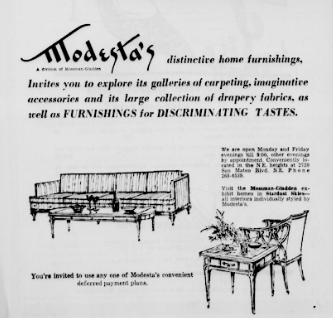






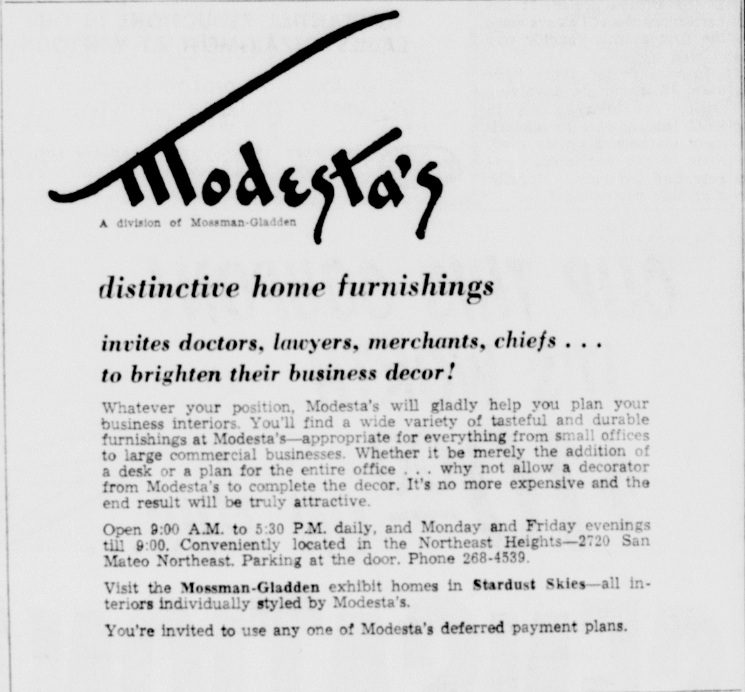
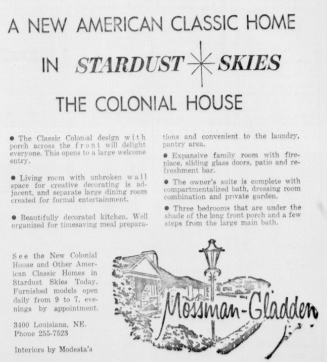
Wrought Iron Details in Four Hills
Wrought iron is a traditional material used in the construction of residential properties in the United States for centuries. The material is known for its durability and ornate designs, making it a popular choice for gates, railings, and other decorative elements.
Wrought iron first became popular in the late 19th century, during the Victorian era. Architects and builders were looking for ways to add a touch of elegance to homes, and wrought iron offered the perfect solution. The material was used to create intricate designs and patterns that were used to decorate everything from fences to staircases.
However, despite its popularity, wrought iron is no longer widely used in residential construction. This halt in use is because the production of wrought iron became too expensive and labor-intensive, making it less cost-effective than other materials. Additionally, the development of new materials, such as steel and aluminum, made wrought iron less appealing to builders and architects.
In Four Hills Village, Albuquerque, a luxury country club development built in the late 1950s through mid-70s, several homes took influence from Spanish and Mediterranean architecture and their wrought iron details. Touring the area, you will find dozens of homes with original and frequently intricate wrought iron window coverings, fences, gates, and lamps. The Four Hills Village Project went on a walking tour through the neighborhood to locate and document instances of this discontinued building material.
Wrought iron details in Four Hills Village. January 20, 2023. Photo by Kimberli Roth.
Today there are many imitations of wrought iron, such as "wrought iron look" aluminum or steel, which lacks durability and authenticity. By looking closely at the material, you can tell actual wrought iron from fake. Wrought iron will have a rough, textured surface and be heavier than other materials.
Wrought iron can still add value to a home despite the decline in its use. The material is considered a classic and timeless design element, and the intricate patterns and designs created by wrought iron are still appreciated by many.
In conclusion, wrought iron was once a popular material used in residential construction in the United States, known for its durability and ornate designs. However, wrought iron is no longer widely used due to its high cost and labor-intensive production. But it still can add value to a home and be appreciated by many.
Live Better Electrically: The Gold Medallion Influence in Four Hills Village
In the 1950s, the Medallion Homes program was launched nationwide to promote electricity use in new home construction. The program was produced in collaboration with General Electric (GE) and Westinghouse corporations, who co-sponsored a multi-million dollar nationwide campaign to promote the sales of electric appliances and tout the benefits of electric power. The program was supported nationwide by over 900 electric utilities and 180 electricity manufacturers. It launched through various media outlets, including a free 70+ page brochure sent to homeowners, magazine and newspaper ads, TV spots, and radio jingles. We have also found instances of “Live Better Electrically” advertisements published by trademarks of General Motors, American Motors, & Radio Corporation of America.
The leading campaign spokesman was Ronald Reagan, the host of "General Electric Theater."
Better Homes & Gardens. October 1958 pg 179
Albuquerque Journal. November 25 1959 page 13
The Medallion Homes program sought to sell 20,000 all-electric homes nationwide within a year. To qualify for a Medallion emblem, a house had to be solely sourced with electricity for heat, light, and power. The kitchen had to have electric appliances, including a range or built-in oven and surface units and an electric refrigerator or refrigerator/freezer. Other requirements to earn the Medallion include an electric water heater and a specified number of outlets and switches per linear foot of wall space. The homes that met these standards could be marked with a 3” inch brass plaque decorated with the “Live Better Electrically” logo, typically found near the front entry door.
Typical Medallion Home Plaque
Albuquerque Journal. February 9, 1958
The program was popular among home buyers in the 1950s, allowing them to purchase a new home fully equipped with the latest technology. Additionally, the program helped promote the use of electricity in new home construction, which was an essential step toward the widespread adoption of electricity as a primary energy source in the United States. However, the program was not without its criticisms. Some criticized the program simply for promoting the use of electricity, which at the time was primarily generated by coal-fired power plants, over other forms of energy, such as natural gas. Some criticized the program for focusing on consumerism and materialism rather than addressing more significant issues such as affordable housing and energy conservation.
Better Homes & Gardens. October 1956 pg 141
Albuquerque Journal. March 23, 1958
Four Hills Village, a brand-new luxury development, was one of several locations in Albuquerque, New Mexico, where the Medallion Homes program became popular. This country club community, founded in 1959, was known for its high-quality construction and attention to detail. One notable example of a Medallion Home in Four Hills Village is the custom home at 903 Warm Sands. Built by renowned builder Rex Boyden in 1960, this home was designed with luxury, and no expense was spared. Features such as air conditioning and state-of-the-art electric kitchen appliances were included, making it a highly desirable property at the time. The Medallion seal on the advertising served as a symbol of its exceptional quality and craftsmanship. The Medallion rating was seen on homes in Four Hills into the late 60s, an example of this being the Cullers & Peppers construction on Sagebrush Trail in 1968.
Village Realty Ad in Albuquerque Journal September 10, 1961
Albuquerque Journal. July 27, 1958
Fast forward to the current decade, owning an electric home in Four Hills Village still offers many advantages for homeowners. The luxury features and future-minded design of houses from the 1950s and 60s continue to provide benefits today. One of the main advantages of electric homes is their energy efficiency, which can result in lower energy bills for homeowners. Furthermore, as the emphasis on renewable energy sources increases and the cost of solar panels and batteries decreases, electric homes are becoming a more cost-effective and environmentally friendly option. Additionally, many electric homes are equipped with smart home technology, allowing them to control and monitor their energy usage remotely, leading to even more energy savings and convenience. With the ever-increasing demand for energy-efficient buildings, owning an electric home also increases the property's value.
Albuquerque Journal. November 9, 1958
In conclusion, the "Live Better Electrically" (LBE) program and the Medallion Homes campaign were essential parts of American history. The program helped promote electricity use in new home construction and contributed to the widespread adoption of electricity as a primary energy source in the United States.
Sources:
"Medallion Homes Electric Homes Program" by John Smith, Journal of American History, Vol. 55, No. 4 (Mar., 1969), pp. 756-764.
"Electric Dreams: The Rise and Fall of the American Electric Home" by William R. Smith, Technology and Culture, Vol. 45, No. 2 (Apr., 2004), pp. 337-358.
"The Medallion Homes Electric Homes Program and the Promotion of Consumerism in Postwar America" by Jane Doe, Journal of Consumer Studies, Vol. 32, No. 3 (Fall, 2008), pp. 245-256.
“Live Better Electrically: The Gold Medallion Electric Home Campaign” by Michael Houser, State Architectural Historian Department of Archeology and Historic Preservation. Link
“903 Warm Sands Realty Advertisement”; by Village Realty, Albuquerque Journal (Sept.,10, 1961) pp. 47
Slats Wilson Ads for Four Hills Village Lot 5 - 1964
When researching various addresses in Four Hills Village, I stumbled across a series of realty ads that struck me as different and telling of the era versus the thousands of house description builders ads I’d seen. They were not selling homes and didn't have rigid walls to describe. The Slats Wilson’s Village Realty ads sold Albuquerque a lifestyle, a dream, and a vision. “A selection of your lot today… a promise of a home tomorrow.” The campaign was launched in 1964 to sell empty land in lot 5.
Developer Bill Brannin had a clear vision from the beginning of Four Hills Village in 1959 and he onboarded founding residents with promises of a luxury golf course neighborhood with custom-built mansions and sprawling open spaces. By 1964 the business-minded developer primarily handled the money talks with stakeholders and politicians. Slats Wilson’s Village Realty, the exclusive developer for lot 5, was charged with selling the vision to the general public. The lots in area 5 were the smallest, with lot 1 having the most significant acreage per house. Wilson was also charged with onboarding a discriminating population (their words, not mine) for the new 590 homes to maintain the air of prestige that Four Hills Village had become synonymous with.
Young executive families were the ideal client. In the 1960s the average home buyer was 23 years old. Marketing men working for the development pulled the heartstrings of parents all year. Ads had drawings of kids and photos of babies; some were even written from the child's perspective. This is all very interesting considering the residents of the development fought to forgo sidewalks because “they didn’t want children playing on them”.
One such series in the 1964 campaign that I found to be uncharacteristically creative for the era were ads that ran with no attribution and simulated letters between friends.
This particular year was unique in that it was selling the future based on the success of the past. Village Realty repeatedly touted a school that never came to be and shared maps of the golf course, with the course starting not at the club as it is today but near plot 1.
What trends do you see in these vintage ads from 1964?
March 15th, 1964, Slat Wilson’s Village Realty Advert showing the plat map for lot 5.
March 22nd, 1964, Slat Wilson’s Village Realty Advert stating 590 lots available.
April 12th, 1964, Slat Wilson’s Village Realty advert Winrock and Coronado shopping nearby.
April 15th, 1964, Slats Wilson’s Village Realty advert that states The Albuquerque Board of Education has purchased 17 acres in Four Hills for future 9 grade school.
April 19th, 1964, Slats Wilson’s Village Realty advert; the prestige of Four Hills Village is a known fact!
This ad ran on two back to back dates. April 26th &27th, 1964, Slats Wilson’s Village Realty Advert with plot 5 map.
May 10th, 1964. Slats Wilson’s Village Realty advert with a drawing of a fashionable woman encouraging a gift for mother.
May 17th, 1964; Slats Wilson’s Village Realty advert with lots of details, maps, and drawings.
May 24th, 1964, Slats Wilson’s Village Realty advert with a picture of a baby.
June 7th, 1964, Slats Wilson’s Village Realty advert, saying that school sites were established and 590 new homesites offered.
This ad ran on two back-to-back dates. July 9th & 10th 1964 Slats Wilson’s Village Realty advert for “Area No. 5”
July 14th, 1964, Slats Wilson’s Village Realty advert; feather your nest.
This ad ran on two back-to-back dates July 17th & 18th, 1964, Slats Wilson’s Village Realty advert with a drawing of a woman wearing a crown.
July 22nd, 1965, Slats Wilson’s Village Realty ad with drawing of a young girl.
July 26th, 1964, Slats Wilson’s Village Realty advert with drawing of a young boy on a rocking horse.
July 28th, 1964, Slats Wilson’s Village Realty Ad with drawings of young executive men.
September 6th, 1964, Slats Wilson’s Village Realty advert about Amy Tattler.
September 28th, 1964, Slats Wilson’s Village Realty Ad as a letter from Tom to Marty.
September 24th, 1964, Slats Wilson’s Village Realty advert as a letter to Butch from Johnny.
October 15th, 1964, Slats Wilson’s Village Realty advert; invest and enjoy life with greater returns.
October 18th, 1964, Slats Wilson’s Village Realty advert; Near schools site - proposed 9-grade school. Albuquerque School System purchased a school site in November 1963.
To see more vintage ads for Four Hills Village be sure to follow us on instagram and sign up for our newsletter.
Stu Hill
The best way to describe Stuart C. Hill is Custom Home Builder. He was a builder and general contractor, not an architect. But his name is associated with beautiful custom houses and offices across the valley. In resale ads and home highlights, you will see “Custom by Stu Hill” or “Stu HIll: General Contractor.” Most of the records we have show him as the contractor fulfilling the design plans of Albuquerque architects. However, a resale ad from May 26th, 1968 for 716 Wagon Train says the house was “Designed by Hill.” So we know he did at least dabble in house design occasionally.
May 26th, 1968
In the late 1950s, you start to see Stu Hill’s name pop up in Albuquerque newspapers. Around this time, he started the Stuart C. Hill Construction Co (occasionally written as Stewart C. Hill Construction Co for some reason). Throughout the 1960s, he and his company built custom-designed houses and office buildings for some of Albuquerque’s upper echelon. In 1965 he built a large office complex for E.M. “Slats” Wilson (one of the Four Hills founders) to house his new corporation. In 1966 Stuart C. Hill Construction Co. crafted the unique stonework home of Ben Abruzzo; famous for piloting the Double Eagle II, the first hot air balloon to cross the Atlantic, and starting the Albuquerque Balloon Fiesta. Ben was also the president of the Sandia Peak Tram Company and Sandia Peak Ski Company. Abruzzo’s house was designed by Max Flatow and constructed by Hill out of natural stone and rough-sawn hemlock.
Abruzzo House, Sandia Heights, January 7th, 1968
February 3rd, 1972
November 22, 1977; Realty Ad for Stuart Hill Home in the foothills.
September 29, 1976; Realty Ad for Stu Hill custom homes in Glenwood Hills.
On top of the homes he built throughout Sandia Heights, Glenwood Hills, and Placitas, Stu has several custom builds right here in Four Hills Village. We know 716 Wagon Train was built in 1965 with a permit pulled for the lot by Charles Reule, another Albuquerque builder, but the resale ad mentioned above attributes the design to Stu Hill. One month later, Charles Reule also applied for a permit to build 800 Wagon Train. Both houses are right next to each other and have similar modernist influences and designs. We have not found any evidence that Stu designed 800 Wagon Train, but it seems highly plausible. It would be interesting if an Albuquerque builder hired a competitor to design the house he was constructing. For now, it is a mystery.
July 15, 1965
August 5th, 1965
Oct 10, 1966; Another newspaper clipping shows Stu Hill applying for a building permit for 1521 Sagebrush Trail.
In 1968, there was a Journal Of Home Living highlight of a house at 1125 Cuatro Cerros, with Stu as the contractor, built for the Clems, a family that moved here to work at Sandia Labs. Mr. and Mrs. Clem helped design the house. They went with a shape of two squares intersecting at an angle with each other. This allowed for views of both the Sandias and the West Mesa. It is a flat-roofed ranch-style house with beautiful redwood fencing along the front.
Surviving blueprints from 1963 show Stu Hills' name, confirming he was also the builder of Colonel Freshwater’s custom-designed home at 1005 Warm Sands Dr.
Stuart C. Hill circa 1974
Every home in Four Hills built by Stuart C. Hill Construction Co. is an excellent example of 1960s modernist design. The quality and craftsmanship are impressive, with each residence standing its ground with great pride for over half a century.
Stu was an accomplished builder. He won Builder of the Year 1971 from the Building Contractors Association and was an executive officer for several organizations. Stu Hill held the second vice president and eventual president seats in 1970 & 1971 for the Albuquerque Homebuilders Assoc. and was the Building Contractors of New Mexico Association president in 1974.
The early seventies was when Hill became involved in politics. From 1972 into the late 1980s, he was a State Representative for the Northeast Heights District. Still the entrepreneur, Stu did all this while running his contracting business. No obituary has surfaced for Stu, so our team does not have info beyond the 80s.
Throughout his life, Stu Hill was a talented and influential character in Albuquerque, NM. Undoubtedly, his industry and the city's landscape were made better by his endless ambition and dedication to his craft. We hope to continue finding information about his work and would love to discover any more homes in Four Hills Village made possible by Stuart C. Hill Construction Co.
--
Four Hills Houses by Stu Hill
716 Wagon Train (designer)
1125 Cuatro Cerros
1521 Sagebrush Trail NE
1005 Warm Sands Drive SE
Resources; can be recalled using the ABQ Library Newspaper Archive Library Edition which is free but requires a library card.
May 26, 1968 - Window Shopping in Four Hills?
July 15, 1965 - New Building To Be Erected
January 7, 1968 - High Elevation House Has Rustic Stone, Wood Exterior
July 15, 1965 - Permits Issued For Two Houses
August 5, 1965 - City Permits Issued For Houses
February 18, 1968 - Squares, Angles Are Basis for Contemporary Home
October 11, 1971 - Builder of the Year
September 30, 1972 - Leslie to Assume Top Post In Home Builders Assn
April 2, 1974 - Rep. Hill announces
800 Wagon Train: Growing Bananas
On September 24th, 1972, residents of Albuquerque became aware of a rare treat happening in Four Hills Village. Mrs. Arms, the prolific gardener at 800 Wagon Train Drive SE, was enjoying her first banana harvest. Mrs. Arms was an influential gardener with strong ties to Albuquerque's Horticultural Society.
On September 24th, 1972, residents of Albuquerque became aware of a rare treat happening in Four Hills Village. Mrs. Arms, the prolific gardener at 800 Wagon Train Drive SE, was enjoying her first banana harvest.
Mrs. Arms was an influential gardener with strong ties to Albuquerque's Horticultural Society. She was encouraged to get into bananas by her husband's father, who had lived in South America for some time. Mrs. Arms was a knowledgeable gardener and said that banana trees like hers were a type of grass; they grow in clumps and fruit only once.
Published September 24th, 1972 Mr. & Mrs. Arms of 800 Wagon Train Drive harvest bananas from their indoor atrium.
Original image courtesy of the Arms Family
Though we have not been able to confirm the designer of the residence, we do know the Arms home was custom built in 1965 with gardening in mind. Features include built-in planters, a natural stone fireplace, and the crowning jewel, a glass-roofed atrium that lets in the sun and regulates humidity and temperature for her collection of exotic tropical plants, including her banana trees.
Original image courtesy of the Arms family.
August 5th, 1965.
Imported to Albuquerque in March 1971, it took Mrs. Arms 18 months to mature the 6-8 inches long stock to over 16 feet tall. Because it was pushing against the glass roof of the atrium, Mrs. Arms cut the tree back several times. Had the tree grown outside, it could have reached a height of over 24 feet.
Family photo of banana tree courtesy of the Arms family.
Family photo under the glass atrium courtesy of the Arms Family
When Mrs. Arms was celebrating Albuquerque’s first banana harvest, she had three more trees growing to maturity alongside several orchids.
Family photo of banana harvest courtesy of the Arms family.
Over time the atrium became a structural issue. In modern-day, that area of the house has undergone renovations and is no longer glass roofed.
Original image courtesy of the Arms family.
If you have a Four Hills Village story to share please get in touch with us at rothheadquarters@gmail.com or @fourhillsvillageabq on Instagram.
Why Four Hills Village Doesn't Have Sidewalks
Sure, we all know that Four Hills Village is the realization of developer Bills Brannin’s vision of a preeminent neighborhood full of large, beautiful, custom-built homes in the Albuquerque foothills. What you may not know is why the neighborhood is largely and inconsistently sidewalked, an issue that has been discussed and speculated from the inception of Four Hills Village to today. Was it an oversight, negligence, or perhaps… a conspiracy?
Where the Sidewalks End
With the post-war economic and manufacturing boom, the number of automobiles on the roads skyrocketed and roads became less safe for pedestrians. Enter: the Sidewalk, protector of children, separator of foot and vehicle traffic, a nessesary solution however inelegant. From West Mesa to Tramway, South Valley to the North Valley, and Old Town to Uptown, Albuquerque is well laid with sidewalks. It may be a long, hot trip, but if there’s somewhere you want to go, you can walk there safely out of the road. Except for Four Hills Village.
Sure, we all know that Four Hills Village is the realization of developer Bills Brannin’s vision of a preeminent neighborhood full of large, beautiful, custom-built homes in the Albuquerque foothills. What you may not know is why the neighborhood is largely and inconsistently sidewalked, an issue that has been discussed and speculated from the inception of Four Hills Village to today. Was it an oversight, negligence, or perhaps… a conspiracy?
In 2022, residents research and speculate sidewalk issues on social media.
Let’s go back to 1959, the year that the Four Hills Country Club opened. In the Albuquerque Journal article ‘“Footpath” Plan To Be Studied In Four Hills”, City Planning Director Harry Coblentz recommends his planning commission oversee, implement, and enforce the city’s new sidewalk initiative. See, every homeowner was required to install cement sidewalks at their own expense for the safety of children. The due date for city-wide installation was set for December 23, 1967, and homes that failed to comply would be worked into an assessment district by the city; which would seek bids, get contracts, and then bill the homeowner for the work in monthly installments. A lien would be placed against the property until the city was reimbursed. All new residential construction was required to have sidewalks installed or risk citation for being uncompliant with Albuquerque sidewalk ordinances. Exceptions to the policy would be few.
April 30th, 1959, ‘Footpath’ Plan to be Studied in Four Hills alongside image of Four Hills Village Country club due to open in May 1959.
According to that same article, the residents of Four Hills Village did not want sidewalks. Developer Bill Brannin would ensure his customers got what they wanted by insisting the terrain in the hills was simply too rough for sidewalk installation. Coblentz, seemingly willing to play nice with Brannin, suggested that exceptions could be made as long as alternate footpath plans were included on the plat (a map showing plot divisions). Brannin was told to get with the city planning department to work out suitable sidewalk arrangements. Stipulations are added that state when that plan comes up for consideration, the commission also will consider an amendment to the city sidewalk ordinance, which may allow for exemptions.
About a year later the Journal published an article titled “Sidewalk Requirements Ignored in Four Hills” which highlighted that a year had passed since developers of FHV asked the City Commission to waive the building code requirement that sidewalks be built in front of all new residences—contending that lots are too big and country too rolling to make sidewalks practical. FHV was to present a workable plan to be reviewed by the City Planning Commission as a revision of the FHV subdivision plat. The plan was never presented, and no sidewalks were going up. Inspection Supervisor Garland, the man in charge of giving official city approval for homes and citing code violators, told reporters he was not waiving the requirement when builders came in for permits. As far as he is concerned, these sidewalk-free homes in Four Hills Village violated the city building code. Yet, Garland was not issuing citations to FHV homeowners at all. At this same time, the city was assessing sidewalks in older neighborhoods made from what was now considered unfit materials. So, Four Hills Village was practically, though not technically, exempt while other residents were expected to abide by the law.
May 8th, 1960.
This is where the story gets interesting. Well, as interesting as a story about sidewalk ordinance enforcement gets.
The issue was seemingly resolved, or at least forgotten about, until over half a decade later, when Albuquerque Tribune staff reporter Jim Boyer runs with the story for months. Beginning on October 28, 1966, we found his article titled “City Administration Is Facing “Trouble” on Sidewalks Issue”. This was a political piece reminding the public that the City's election is coming up the following October, and sidewalk ordinances against new construction are not uniformly enforced. Boyer doubts that regulations will be enforced in Glenwood Hills and Four Hills Village. The two recent developments did not comply with new construction ordinances yet received no citations. When asked about this, Garland, our favorite inspection supervisor, skims past the issue saying, “That’s something I plan to talk to the commissioners about.”
The following month, the Journal publishes “Garland Pleased With Progress on Sidewalks Law”. Inspection Supervisor Garland used the opportunity to defend new homes in FHV being constructed against ordinance with no sidewalks as they hadn't yet been “finaled out” (accepted by the city.) He expects them to have sidewalks by December 23, 1967, unless householders make appeals or commissioners decide otherwise.
Now, the Four Hills Village sidewalk story was getting attention, and a day later the Tribune publishes another article. This one was not as chipper as yesterday’s Journal story, where Inspection Supervisor Garland tried his best to control the narrative. The headline reads “Sidewalk Ordinance Study Due for Glenwood, 4 Hills” again by investigative journalist Jim Boyer. Garland admitted to city commissioners that ordinances were not being strictly enforced in FHV. City Commissioner John Gurule made it clear he wants the city ordinances to be implemented on an equal basis and suggested a study be performed on the situation. When questioned about the oversights in Four Hills, Garland said he interpreted some papers to mean he need not enforce the ordinance in FHV and was waiting for someone “to bring the matter up”. Besides, he countered, he was not “finaling out” FHV houses that did not have sidewalks, thus not granting official city approval. However, a loophole is exposed after he is coerced to admit, under questioning by the City Commissioners, that there is no consequence for living in a home that has not been “finaled out” by inspectors. When asked, “What can the City Commission help to do your job?” Garland responded “nothing” and said ordinances would be issued a year from now on December 23rd, 1967, when all older homes were expected to comply.
Exactly one month later, Jim Boyer publishes a showstopper of an exposé. On December 9, 1966, “Failure to Enforce Sidewalk Law May Spark City’s Next Campaign” reveals a significant motive for the sudden interest in the sidewalk story. Jim says that lack of standardized enforcement and policy inequality may become a hot campaign issue for the City Election less than ten months away. At a campaign panel discussion, three candidates briefly talked about the City Public Works Department not enforcing sidewalk law in Four Hills, but the issue was left hanging in the air, and no candidate came to a yes or no on the subject.
Inspection Supervisor Garland told reporter Jim Boyer that none of new houses in Four Hills Village that have gone up without sidewalks since December 1965 were occupied. A few days later, he corrected the statement that he “thought” they weren't occupied; two were. Garland also said he had only issued ten house permits in FHV after Dec 23, 1965, when the sidewalks for new builds ordinance was put in place. When the reporter checked, it turned out that 19 permits were filed. City Commissioner John Gurule told the reporter he would “keep an eye on the situation” but this along with his earlier stated commitment to the equitable application of ordinances amounted to nothing.
Along with the article, all 19 addresses from 1966 were “put on blast” published:
1101 Stagecoach SE, Feb 3rd
910 Toro SE, Feb 6
644 Running Water Circle SE, March 31
900 Cuatro Cerros SE, March 9
1017 Cuatro Cerros SE, March 14
914 Toro SE, April 21
1404 Sagebrush Trail SE, April 1
1028 Matador SE, June 30
1408 Sagebrush Trail SE, June 14
906 Four Hills Road SE, June 13
908 Wagon Train Road SE, July 12
819 Toro SE, Aug 8
910 WagonTrain Dr. SE, Aug
1024 Matador SE, Aug 4
1012 Bernalillo SE, Sept 27
915 Toro SE, Sept 9
813 Toro SE, Oct 31
1521 Sagebrush Trail SE, Oct 5
1107 Stagecoach Road SE, Oct 5
By December 1, 1967, Judy Nickell tells us in her Soil & Toil column that with the deadline looming, the city has already issued 7,129 permits covering 91.1 miles of sidewalks under the new ordinance. She states that the town allows few exceptions in areas Four Hills and Glenwood Hills, which are “too hilly”. This is exactly what developer Bill Brannon wanted all along when he first requested in 1959 to have the ordinances waived for his luxury development.
One day before Albuquerque is set to begin handing out citations, Investigative Journalist Jim Boyer leaves us with a few final insights and a political plug for Commissioner Payne’s reelection. On December 22, 1967, “Commissioner Word Payne Raps ‘Poorly Arrived At’ Walks Law” is a headline read by thousands of Burqueños. City Planning Director Rueben Rameirz said, ”Sidewalks in residential areas are mainly for the protection of children…Wait until a child gets killed, then they will want to change this.”
Despite the newspaper articles, calls for investigation, and pleas for compliance, the residents of Four Hills Village have won, as City Building Inspector Garland said he had granted 30 waivers to Four Hills residents, so far.
The city is reasonably accused of granting “wholesale” waivers to residents in Four Hills, in many cases never requiring sidewalks to be installed before approval was granted.
In 1967, eight years after the first sidewalk-free home was built, when interviewed about their resistance to sidewalks, people living in Four Hills Village said they don’t want kids playing on them and that sidewalks “detract” from their homes.
So is the reason that Four Hills Village lacks adequate sidewalks because… the residents simply didn’t want them? Yes— but avoiding compliance with the city ordinance would have been impossible without the purposeful inaction of City Inspection Supervisor Garland.
This brings us back to my charge of conspiracy. Garland would be unable to “overlook” those infractions if Coblentz had not transferred the sidewalk initiative oversight to his department in 1959, coincidentally the same year that Four Hills Development really got underway. While we have uncovered no concrete proof to make accusations of Bill Brannin’s political donations or relationships with the parties involved, coincidences abound to ensure that Four Hills never had to comply were certainly known.
In 2022, residents research and speculate sidewalk issues on social media.
Resources; can be recalled using the ABQ Library Newspaper Archive Library Edition which is free but requires a library card.
April 30, 1959 - “Footpath” Plan To Be Studied In Four Hills
May 8, 1960 - Sidewalk Requirements Ignored in Four Hills by Marianne Johnson
October 28, 1966 - City Administration Is Facing “Trouble” on Sidewalks Issue by Jim Boyer
November 8, 1966 - Garland Pleased With Progress on Sidewalks Law
November 9, 1966 - Sidewalk Ordinance Study Due for Glenwood, 4 Hills by Jim Boyer
December 9, 1966 - Failure to Enforce Sidewalk Law May Spark City’s Next Campaign by Jim Boyer
December 1, 1967 - Soil & Toil by Judy Nickell
December 22, 1967 - Commissioner Word Payne Raps “Poorly Arrived At’ Walks Law by Jim Boyer

















